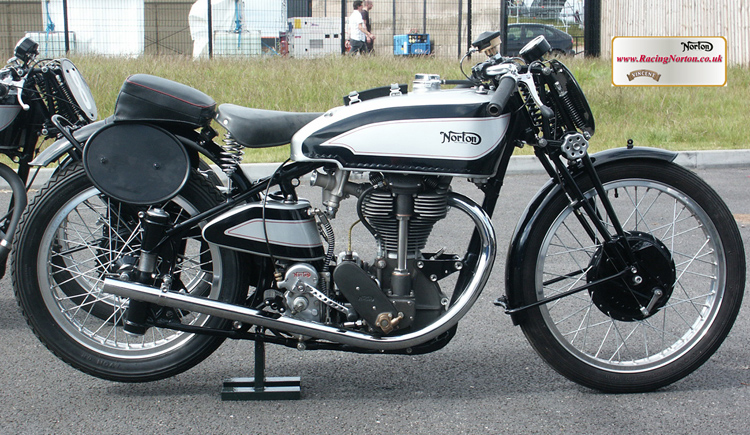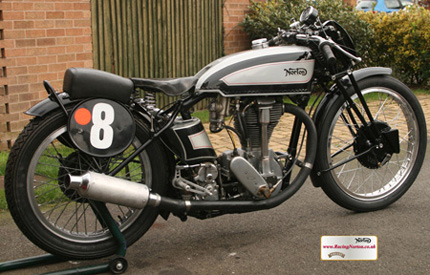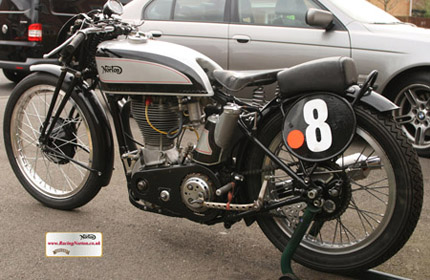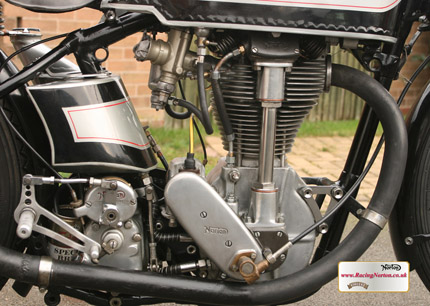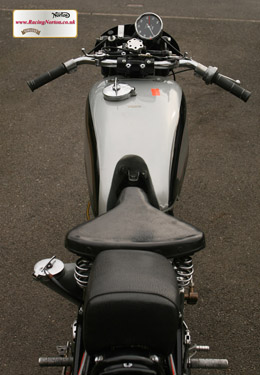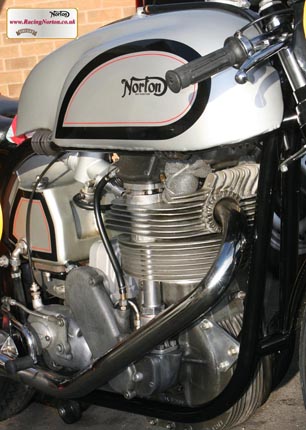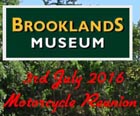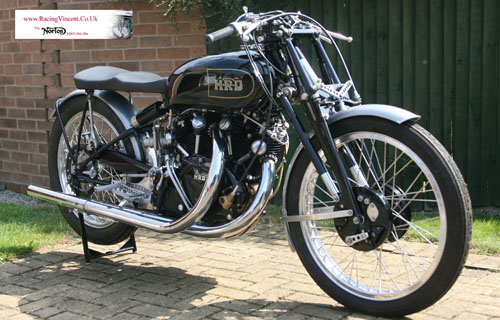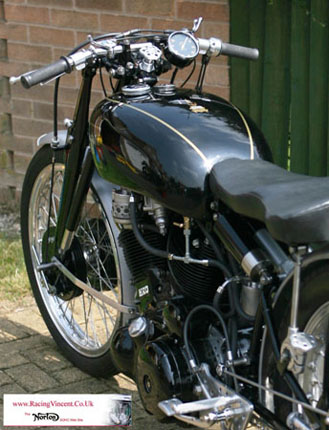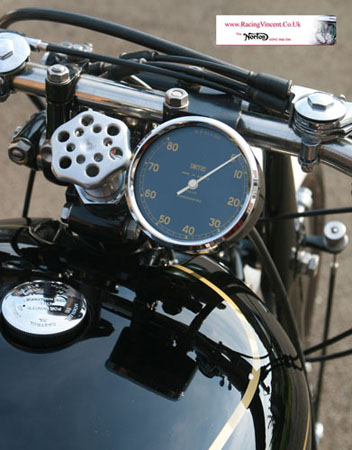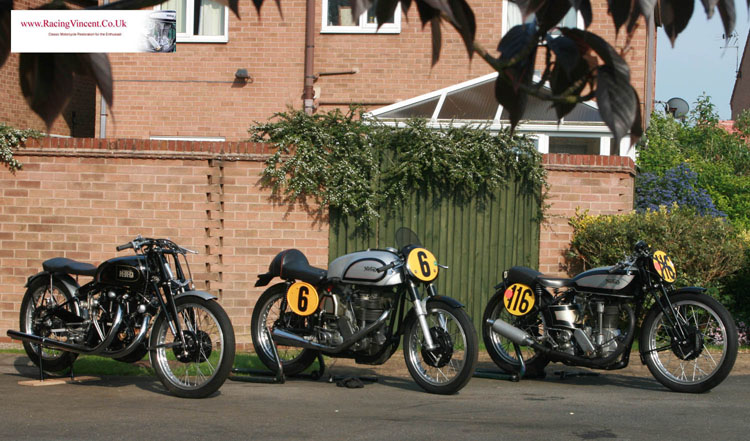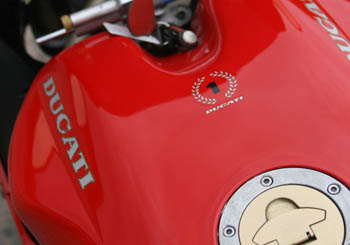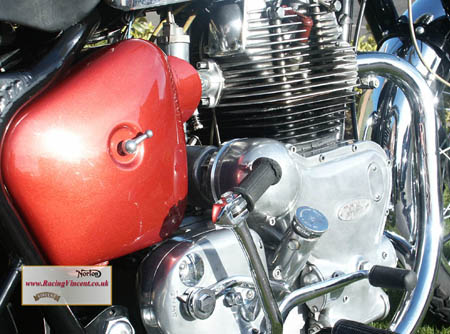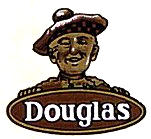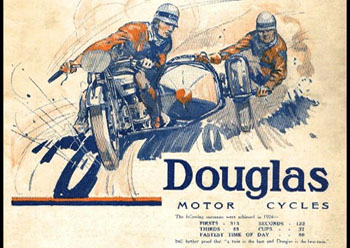This page shows a gallery of some of my current bike collection. Not suprisingly, the emphasis is on both SOHC Norton's and our two Vincent's, but there are a smattering of other bikes as well.
To look at a bigger version of each photograph, click on the photo. If you are going to use these photographs in any other website pages, please credit my name and provide a link to this website, thank you.
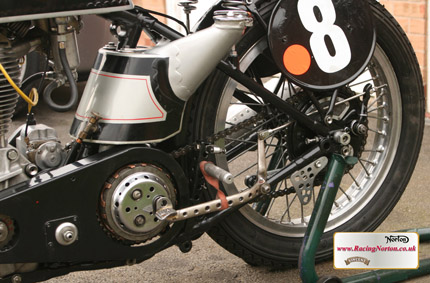 Distinctive wrapround oil tank is a visual icon of Cammy Norton's..
Distinctive wrapround oil tank is a visual icon of Cammy Norton's.. Lliberal drilling and alloy parts keep weight under 300lb
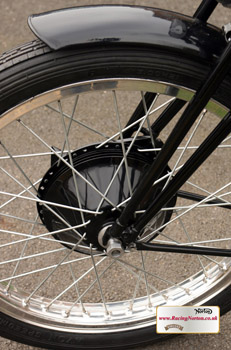 '
'
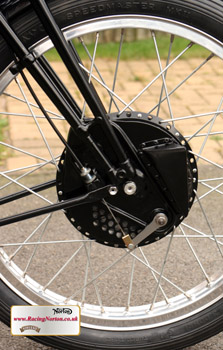 Norton's first conical hub was cast iron, with magnesium brakeplate. Notice drilled spoke flange on drum side - replaced in late 1940's by thicker (undrilled) alloy flange
Norton's first conical hub was cast iron, with magnesium brakeplate. Notice drilled spoke flange on drum side - replaced in late 1940's by thicker (undrilled) alloy flange
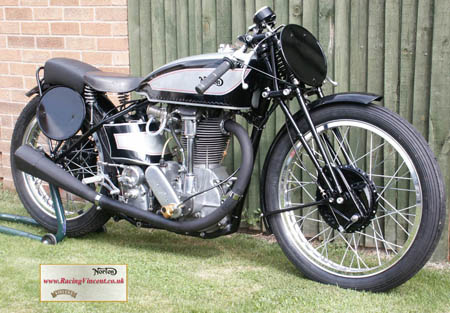 Racing Inter in its orginal guise, when build was first completed. As well as being a bit shinier, it had an open megga in this shot, lower handlebars (not really practical) and a different conical brake
Racing Inter in its orginal guise, when build was first completed. As well as being a bit shinier, it had an open megga in this shot, lower handlebars (not really practical) and a different conical brake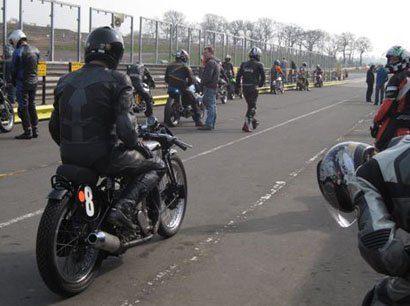
Testing at a Mallory practice day March 2012. Phil Cramp on very fast Velo KTT at lower right - checking his bike is still there
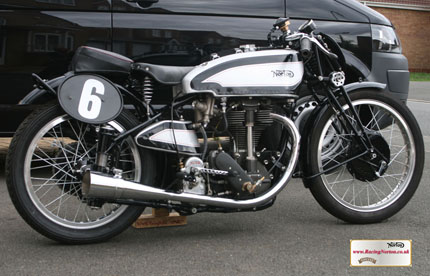 This Manx Grand Prix specification Norton is fitted with the first plunger chassis Norton made - only fitted to Works bikes in 36 - 37 and a few customer bikes in 37 - 38. Often referred to as the Big Plunger type chassis
This Manx Grand Prix specification Norton is fitted with the first plunger chassis Norton made - only fitted to Works bikes in 36 - 37 and a few customer bikes in 37 - 38. Often referred to as the Big Plunger type chassis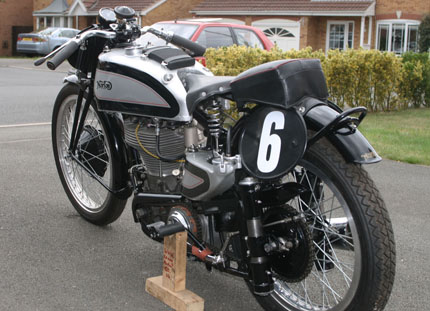 This bike is fitted with a Beart oil tank and what I believe to be a Beart front wheel. A tank identical to this was shown on Lockett's (Works) Beart bike
This bike is fitted with a Beart oil tank and what I believe to be a Beart front wheel. A tank identical to this was shown on Lockett's (Works) Beart bike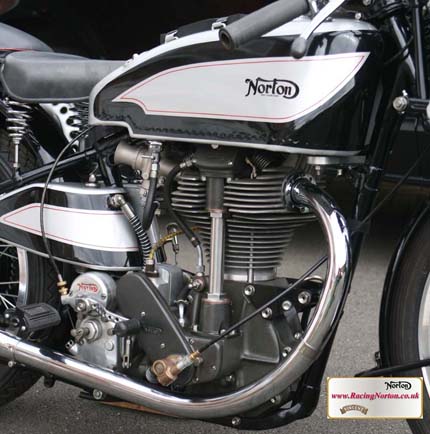 SOHC Engine is full magnesium - including vertical bevel castings and inner/ outer timing covers. Cables are genuine cloth covered 'new old stock' clutch and brake cables are red spiralled competition cables
SOHC Engine is full magnesium - including vertical bevel castings and inner/ outer timing covers. Cables are genuine cloth covered 'new old stock' clutch and brake cables are red spiralled competition cables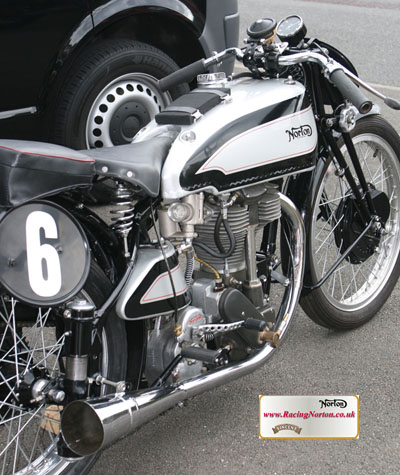
Everything on a Manx is bigger (and heavier!) than an Inter. Large bolt-thru fuel tank is no exception
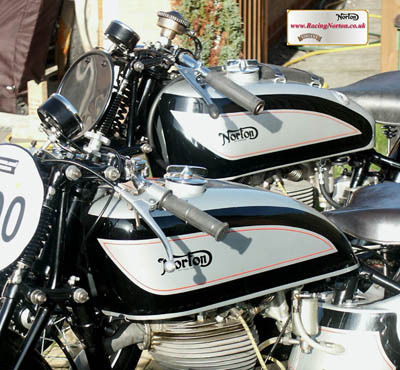
'I like a nice posing shot, me . . .'. A bit of a staged photo this one, but shows interesting comparison between Inter and Manx tanks
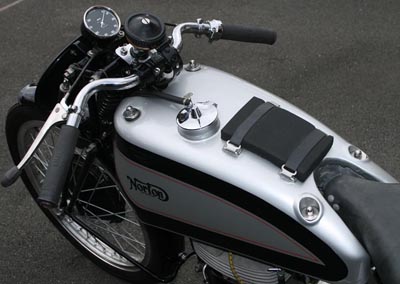
Top cockpit view. Strictly speaking, bolt-thru's were only used on Works bikes pre-war (as far as I know), but I could not resist fitting, as I had one. I also have an almost identical shaped pre-war racing tank, which is none bolt-thru. This still needs restoring, but may be fitted one day
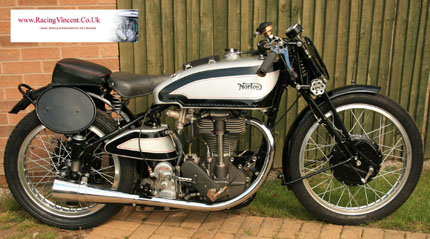
Another screensaver shot - this time after fitting of correct Manx mega with strenghening strap. Click on photo for full screensaver save photo
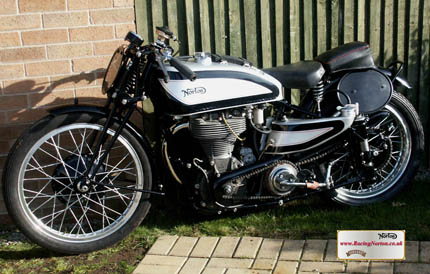 Drive side in the same photoshoot. This shows well the Beart oil tank with quick release filler. Norton themself made a similar tank for their production 1950 Gardengate - the only year the production bikes were fitted with alloy petrol and oil tanks - see the green tank on my 600 Manx below for examples of these
Drive side in the same photoshoot. This shows well the Beart oil tank with quick release filler. Norton themself made a similar tank for their production 1950 Gardengate - the only year the production bikes were fitted with alloy petrol and oil tanks - see the green tank on my 600 Manx below for examples of these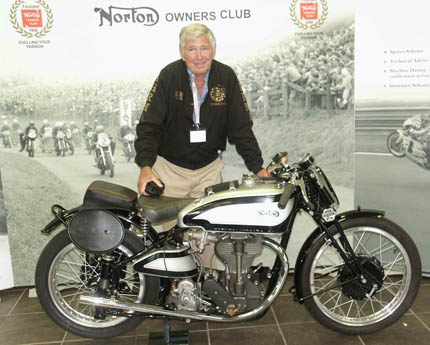
Back in June 2009 I took the Big Plunger Norton to the Norton Owners Club anniversary at Donington Park.
It was a real priviledge to meet legendary motocross (and road racing) star - Les Archer, who had very successfully raced Norton engined Motocross and road race bikes from the 1940's-60's. He was there with his last motocrosser (DOHC style engine, with SOHC cambox) - which had been fully restored.
Because I knew that the 500cc engine I had built into the 38 Big Plunger had the crankcases/bottom end that showed as being supplied post war to Les Archer, it was a great opportunity to talk to him about the bike, and get some background about the engine. He was pleasently suprised to find the engine had survived the test of time - and gave me the opportunity to take this great photo of him with the bike.
If I recount his story correctly - he remembers road racing a Manx Norton in his early days in the late 1940's, and while at a race at Blandford the engine cried enough - with the conrod coming through the front of the crankcases. It was this crankcase number that Norton's supplied him to replace that engine
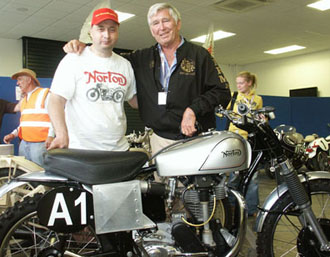
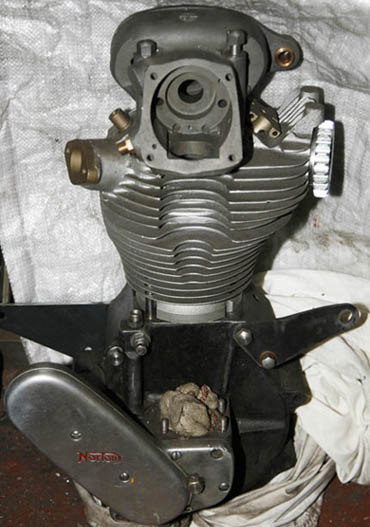
Although the engine in the Big Plunger Manx looks lovely - I always knew it was a 500cc engine and the crankcase number showed it was originally a Post-War engine, while the Big Plunger would originally have had a 'round-fin' 350.
However, I also have this engine which I am intending to rebuild at some time in the future and may swap out with the current engine (which is likely to go in to the 1950 Manx project I also have - see below).
This engine is one of the earliest producution magnesium engines, the crankcase number showing it being 1936 350cc. Head and barrel are correct 'round' type alloy M40, with bronze skull and the head looks almost new. Cambox (only shell in photograph but I have the internals) is also the correct magnesium pre-war type, and like some of the early ones is stamped '40' on the oil feed casting blank. Most importantly - it is of the specification that would have originally been fitted in this particular Manx when new
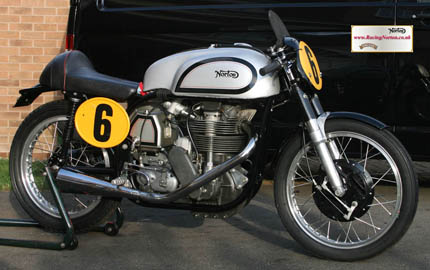 This is my 1955 500 doubleknocker Norton. The engine number shows it to be one of a brace of Nortons supplied to Surtees by Harold Daniels at the start of the 55 season. Surtees joined the Works team for select events that season, but kept his privateer bikes for non championship events.
This is my 1955 500 doubleknocker Norton. The engine number shows it to be one of a brace of Nortons supplied to Surtees by Harold Daniels at the start of the 55 season. Surtees joined the Works team for select events that season, but kept his privateer bikes for non championship events. 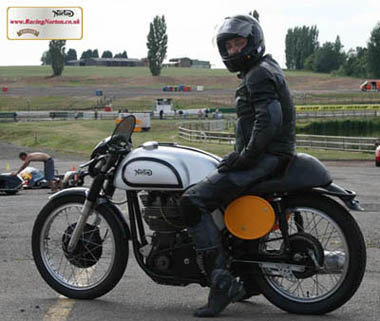
By 1955 the DOHC engine had gone to short stroke configuration and the famous Featherbed frame used a welded up rear subframe
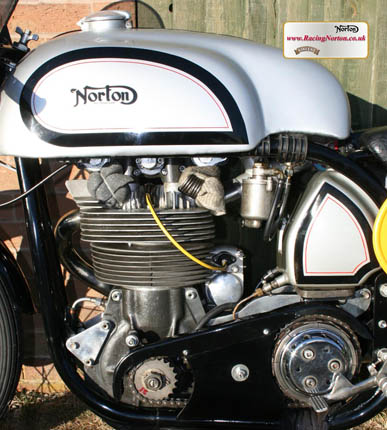 Crankcases have much deeper barrel spigot than SOHC engine. Note Lucas SR-R magneto fitted - correct for 55
Crankcases have much deeper barrel spigot than SOHC engine. Note Lucas SR-R magneto fitted - correct for 55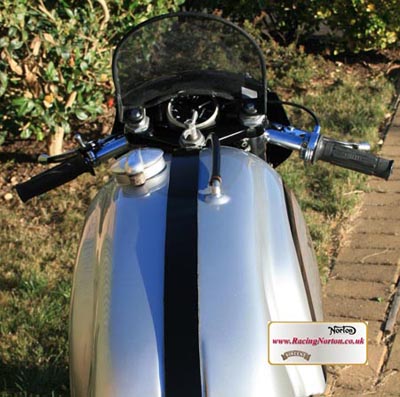
Cockpit of DOHC Manx is very different from earlier Gardengate/Rigid Nortons. They feel about as different to ride as it is possible to be as well - very much different era's of bikes
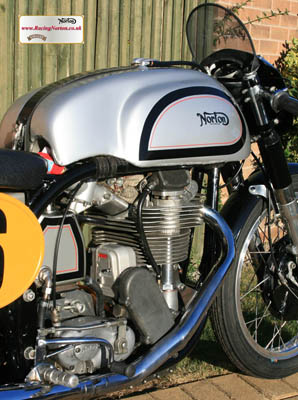
Cloth can just be seen poking through rear of petrol tank, to stop spanners, birds, etc falling down GP carb bellmouth . . . I have tried to start bike more than once with this cloth still in place
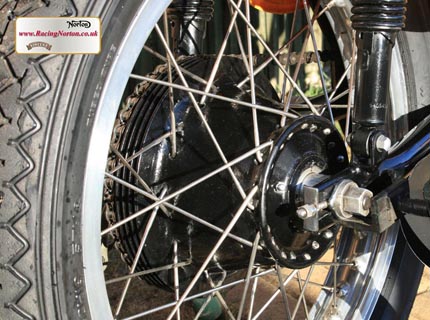
Magnesium conical rear hubs were first fitted to customer Manx's in 1949/50
This one is on my 1955 doubleknocker
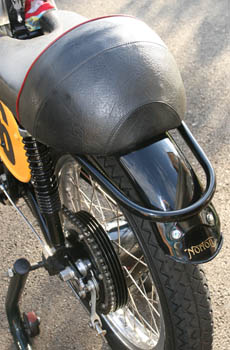
Seat has Works style hump pattern. Notice original subframe hoop, often earlier Manx Nortons have these chopped off, as previous owners tried to make the earlier frames looks like the later ones which did not have this hoop
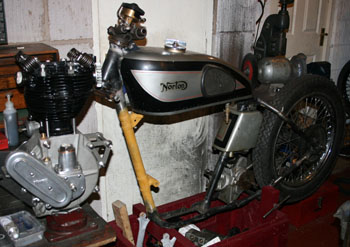
Frame for this bike is of Rigid Racing International type, i.e. it has mounts to take an alloy front tank mount as well as rear footrests. Here you can see the frame sat on a purpose built Norton build platform that allows me to move it around the workshop
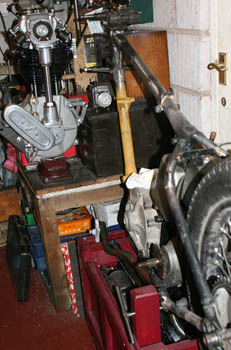
A long way from complete yet. Build platform also has storage area to hold a lot of the smaller build parts
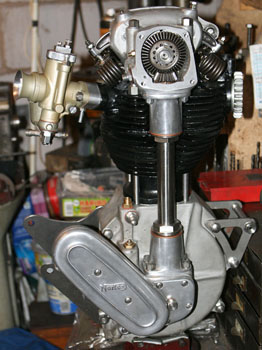
Engine is a nice straight 37 500 cast iron engine, fully rebuilt, using many of my own parts. Bottom half was repatriated from my old friend Arthur Moore in Australia, its build is covered in earlier articles
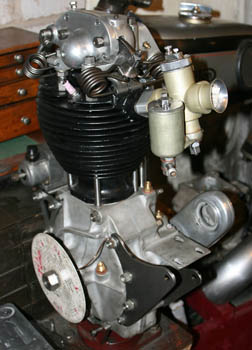
Drive side of Inter engine showing pre-war type TT carb, identifiable by early type floatchamber and minor differences on carb body. A little detail is for this engine I have fitted a lovely Lodge racing spark plug, easily identifiable by its pink colour . . . talking to Ivan Rhodes, he still firmly believes these were the best spark plugs ever made!
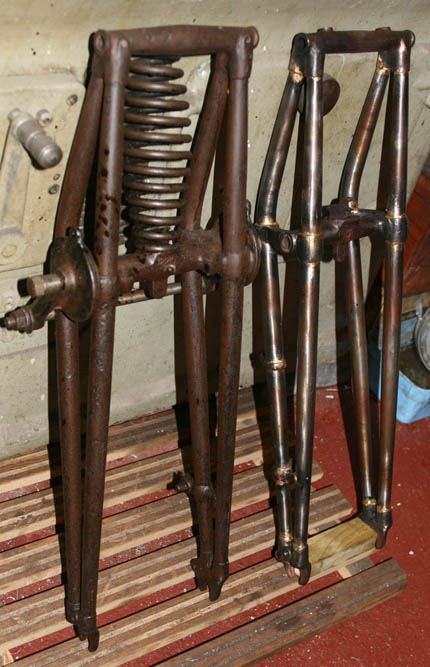
The girder forks on the right in this pihoto were originally reserved for this bike - as they were of the proper pre-war 'Manx' type, notice the lack of side damper on the casting, compared to the standard OHV type on the left. The tubes were damaged when I got them and they had just come back from re-tubing at Jake Robbins when this photo was taken. However, since then, I have decided to build another pre-War Norton, with frame converted to 1938 Gardengate Manx spec, to test our own magnesium pre-war engine. Therefore I need to get the forks on the left cleaned up and converted to Inter spec, for this bike - which has got a proper pre-war 7" Inter hub, which mounts to the right hand fork leg - similar to the racing conical brake.
As can be seen, the fork blades on the left are currently in standard OHV/CS1 spec, with them being wider at the bottom to take the bolt on front brake drum, and left mounted brake plate - therefore some work to do.
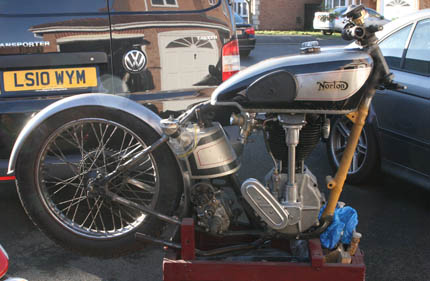
This photo was taken a bit later when the rebuilt engine and other parts (including gearbox which has not been stripped at this stage), were loosely built up. Both oil and petrol tank are correct roadgoing Inter tanks for 1937, Magneto and dynamo were not fitted here, but are in the photo below and of the type originally fitted in 1936 - but close enough!
Rear wheel at this stage is Plunger type, but allows ribbed drum to be used
 In the photo above you can see the pre-war International front brake drum on the right, painted ready for spoking. On the left is the more standard front brake drum fitted to SV/OHV/CS1 models - the 3 stud type that bolted to the 'Cotton Reel' hub, fitted to both front and rear wheels. Genuine pre-war Inter hubs are identifiable from the post war version (fitted post war to all models), because it was a one piece casting. The post war type had the small diameter centre hub riveted to the drum. Because they were fitted on the opposite side, the Inter hub also requires a speedo drive with the opposite type thread and a different gearing to fit the 21" wheel Inters used
In the photo above you can see the pre-war International front brake drum on the right, painted ready for spoking. On the left is the more standard front brake drum fitted to SV/OHV/CS1 models - the 3 stud type that bolted to the 'Cotton Reel' hub, fitted to both front and rear wheels. Genuine pre-war Inter hubs are identifiable from the post war version (fitted post war to all models), because it was a one piece casting. The post war type had the small diameter centre hub riveted to the drum. Because they were fitted on the opposite side, the Inter hub also requires a speedo drive with the opposite type thread and a different gearing to fit the 21" wheel Inters usedUnfortunately, I do not have an original brake plate of the type fitted to the Inter front hub - so have had to make changes to a pre-war OHv type, shown here.
There are two main changes -firstly the brake retaining plate needed to have its rivets removed, and a new brake anchor fitted in reverse - so the brake can be used on the right side of the forks. Then the original speedo drive needed to be filled with a small blanking plate, and a new hole ~(visible at 2pm) drilled. At this stage all the brazing is done, once everything is cleaned up it should be unrecognisible. Note the three holes around the circumference, this is for the internal dust deflector, whihc has been temporarily removed to allow for the brazing. The original anchor plate would not have been brazed - relying on the rivets alone, but I prefer to braze as well as insurance
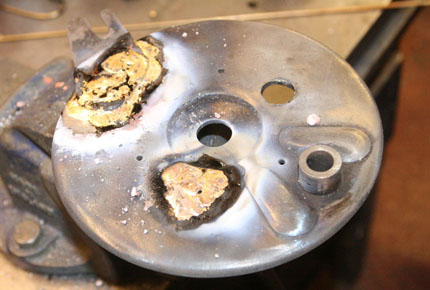
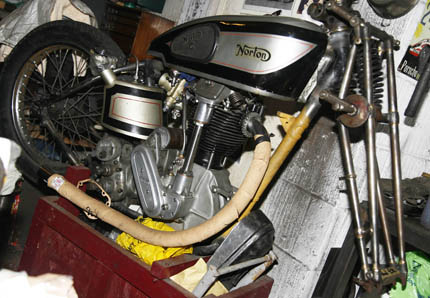
Here is the same bike loosely fitted with retubed Manx girder forks, but normal 'side damper' side plates (proper pre-war racing forks did not have side dampers - instead relying on parallel fork springs. As above - at some point I will get the other girder fork blades sorted and fit those instead.
Note red 'build box' under bike - these is an excellent platform for moving a Norton project around the workshop on, while allowing me to store all the other parts required for that bike
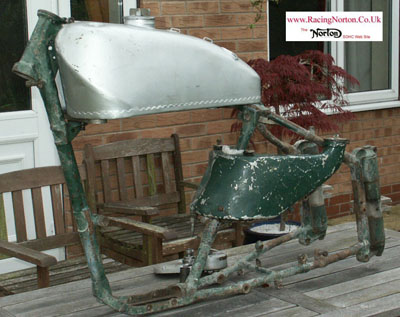
This is the project bike I am really looking forward to restoring - one of only 17 genuine 600cc Gardengate Manx Nortons made (it has E15 chassis number).
Shown here just as it arrived to me from Australia. Records show this was the first 600 delivered to Australia, and only a couple of numbers before Eric Olivers own World Championship winning sidecar outfit
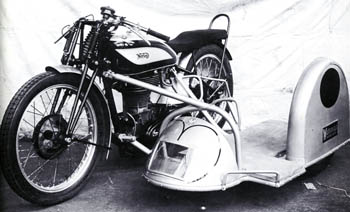
This gives an idea of what I am hoping the complete bike will look like. This I believe was Eric Oliver's similar 600cc Manx, although note that Erics first post war outfit continued to use a rigid chassis - I have a similar sidecar outfit, originally fitted to Titch Allens 'Posing outfit'
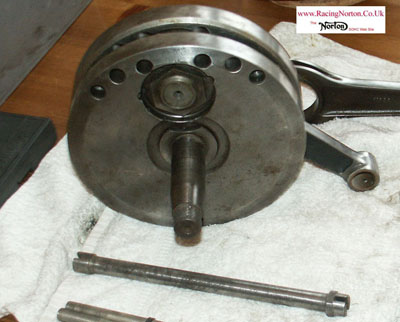
. . . and with the barrel the other super rare' bit I needed to find was the correct 600cc Manx crank - look carefully where the mainshaft 'half moon' cutaway is, and you will see that it is not in line with the recess for the BigEnd nut, which it would be if it was a 50cc crank. Note also the very long length vertical shaft
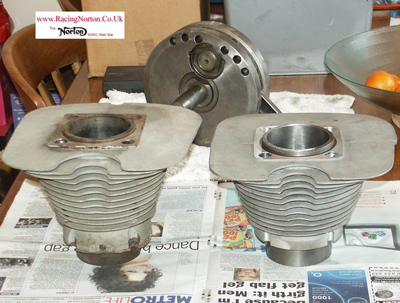
After much searching, I was very fortunate to find a genuine 600cc barrel, seen here on the left. They have one additional fin over a 500cc barrel, as well as a deeper bottom spigot (although in this case the 500cc barrel on the right also has an extra fin!).
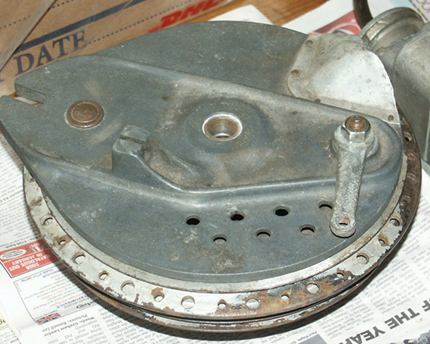
Lovely original post war front conical brake drum and magnesium brake plate - also bought back from Australia at the same time as the frame. Not sure if this was the actual brake fitted to the 600 frame - but it is of the correct type - with the brake plate being slightly different to the earlier pre-war type
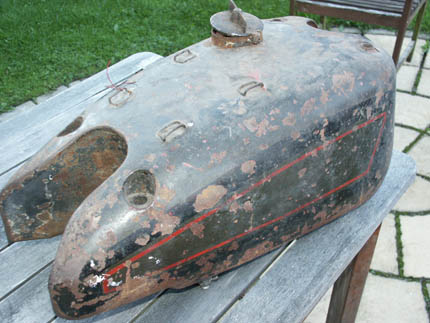
Around the same time as bringing the chassis back from Australia, I also found this very rough Manx petrol tank on E-bay, it being of the same year as the chassis - 48-49. This is identifiable because it is boltthru steel - but is welded not scolloped/soldered. I believe these started in 48. I did bring back from Australia a 1950 alloy Manx tank (again in rough nick) - which I was orginally goiing to fit, but now reserved for my 1950 frame - see below
After much restoration work (including a full dip in special derusting solution which would not have been possible with a soldered tank) and then painting and lining - the finished tank is below, now put to one side until I start work on the rest of the bike
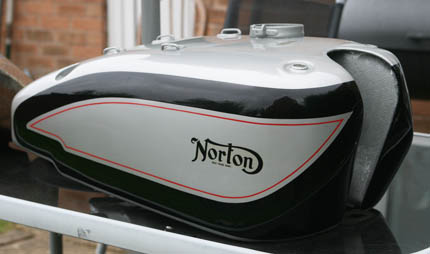
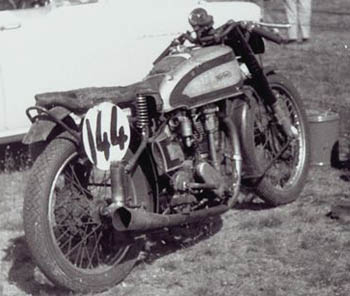
And here is a lovely period shot of how it looked when it was reaching the end of its competetive life. Arthur told me he was given this photo by the person his father bought the bike from, and was told this was approx 62/63 in Australia. By this time the bike was solo, and probably fitted with a different engine
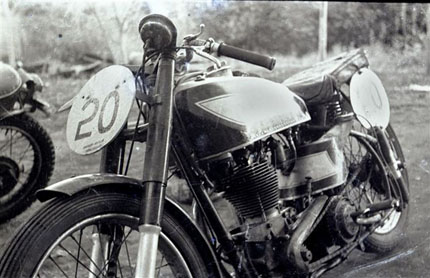
The only other photo I have of the 600 Norton when it was racing in Australia - again, probably late 1950's or early '60's. It looks surprisingly original at this point - other than it looks like it might have been fitted with a 350 engine from the height of the barrel - and does not have a sidecar fitted!
If you look carefully you will also see strengthening tubes fitted to the rear plunger castings - a common mod for Gardengate frames that had a reputation for snapping. Arthur told me his father removed these when they bought the bike in the 1960's
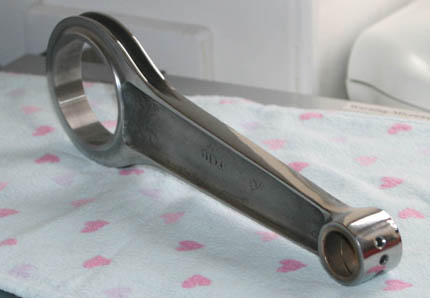
I was lucky to be able to get hold of an original 'New Old Stock' 600 Manx rod from old friend Stu Rogers not long after getting the chassis. Here it is polished before sending off with the original crank to Alpha's to have new Bigend fitted. the photo below shows the 600 crank and new rod all done and ready to go back in an engine. Next to it on the left is a brand new 500 Manx crank with Carillo rod I had made for me by Alphas, using the 600 Manx as a pattern. I did this with a view to being offer similar cranks to customers in the future, but unfortunately with the sad passing of Max Nightingale at Alpha's in 2017, this is unlikely in the near future
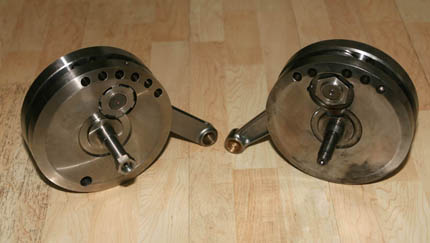

Second set of our pre-Featherbed magnesium crankcases are reserved for my 600cc sidecar engine. Here they are on our crankcases in the early stages. Admittedly, since 2017 we have held off final 'finish' machining - as we have stopped work on them, until I fully test the first engine using our crankcases and ensure we have all dimensions correct (see the 1938 bike below), but no reason at this stage to think they wont be fine. It will be good to have crankcases we can fully trust (as original magnesium can get brittle over the years) - particularly when being used in a full 600cc sidecar race Manx outfit
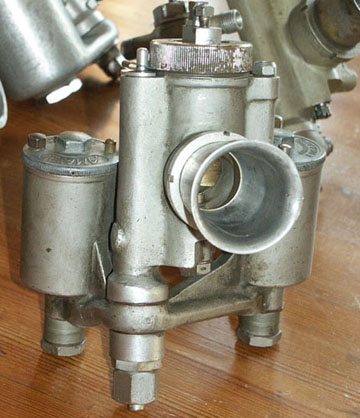
This being a 600cc Manx Norton - I will be putting a racing sidecar onto it (see below) eventually. Being a sidecar racer - it really needs twin floatchambers on the carb to avoid running weak on lefthanders.
So I have been holding back this carb for many years reservedt for this bike. It is a lovely twin carb RN carburettor and is in really nice and original condition. I have only seen a handful of carbs of this type - but I think they were supplied either later pre-war, or early post-war as a speedway engine alternative to the more normal Amal Type 27 needless dirt track carb. Notice the large and distinctive main jet nut at the bottom and distinctive offset twin floats - both correct for this type of carburettor
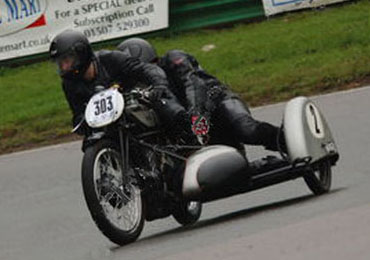
My last time piloting a sidecar - this being the Hairpin as Mallory 1000 Bike Festival 2007 with old friend Andy Phillips in the chair - and what I remember most about this ride was how much the front wheel was crabbing sideways into the hairpin with a 21" wheel with its small contact patch - very different to when I was passengering in VMCC races, where we used modern 18"/19" front wheels with as much tyre as possible - Probably looked good though!
This was not the 600cc Manx outfit however - it was the Big Plunger chassis when fitted wtih a tweaked 600cc OHV engine. However, the sidecar was a purpose built racing chair, the outfit previously owned by Titch Allen. I have passengered in it quite a few times as well and liked it a lot. This sidecar is now reserved to go onto the 600cc Manx project
I also have a couple of other SOHC Cammy build projects for the future:
- 1930's/40's Trials - open frame 500T style with scolloped hub and some 500T parts. Looking for 500T fork yokes and 500T tank. Going to fit SOHC engine in it I think
- Also looking for 1950-53 magnesium front conical wheel and brake plate
- to house our own test M30 (magnesium crankcase) engine - Updated March 2019
As I update this article in late 2018, early 2019 - this bike is still a bit of question mark as to if it will come off ok?. I did not really intend on building this chassis until a long time in the future, as the starting point for it was a non-Manx Gardengate chassis I had put aside some years ago for a future build.
However, circumstances change - and as I realise I am not getting any younger - rather than swapping out the race engine in my 1938 Racing Inter (see top of this page), to test an engine using our M30 magnesium crankcases - I would rather just build it into a complete bike with many of the parts I had reserved for a pre-war 39 Manx Specifiction older, As many of my customers know - whom have been enquiring, I dont mind admitting that getting the engine together has taken much longer to get complete than I originally expected - simply because of other commitments and keeping the other parts in our catalog in stock.
That said, as update this article in early 2019, work is progressing and I have most of the parts needed to build this bike up reasonably quickly (other than petrol tank that is wonderfully original - but does need total restoration. See below photos of some of the parts that form this bike - which I am hoping will be Gardengate 1938-39 spec:
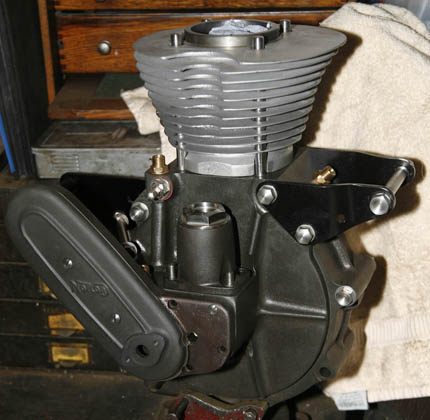
M30 500cc (Pre-War Manx Specification) engine - using our own M30 crankcases. The engine is a full magnesium engine - and is shown here waiting for lower bevel gears about to be fitted - once that is done it can be then fully assembled. It is a 'full' magnesium lower engine - i.e. as well as mag crankcases, it is also fitted with magnesium inner timing covers, magnesium bevel housings - and a lovely ribbed magnesium outer timing cover. Just a few of this final item seem to have been fitted to the Works bikes in 36-37(ish) - i.e. ribbed, but provision for rev clock, but in magnesium alloy..
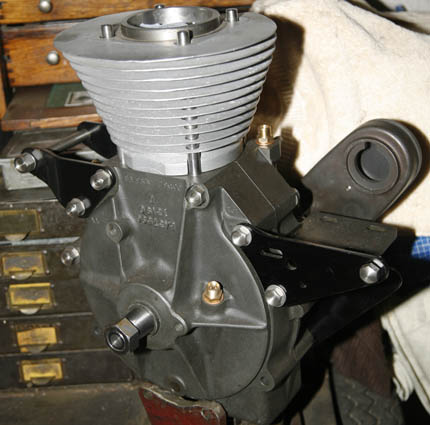
Drive side of the same engine - again, showing the main differences between the (magnesium) pre-War racing M30 engine and International engine - as well as the obvious difference of black/magnesium alloy, you can see that the race crankcases did not have the extra ribbing that followed the contour of the chainscase - as you will just see in the drive side photo of my 37 road going Inter engine above.
As you can see in this photo - I used the opportunity in 2018-2019 when the engine was on its build stand, to use it as as a template for making up stainless steel SOHC engine bolts, which we now offer as a seperate section of our webiste, along with other Inter 350 and 500 bolts:
RacingNorton Engine Bolt Section
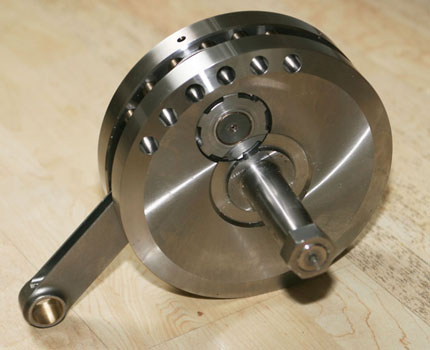
Brand new M30 crankshaft was made for me in 2016 by Alpha's, using my original 1948 600cc Manx crank as a pattern - but for this crank it has standard Longstroke Manx 100mm stroke, and uses Carillo conrod.
It is a beautiful piece of work, and was made with a view to offering these to Special Order from our catalog. Unfortunately with the sad passing of Max Nightingale (owner of Alpha's at the time), this may no longer be viable.
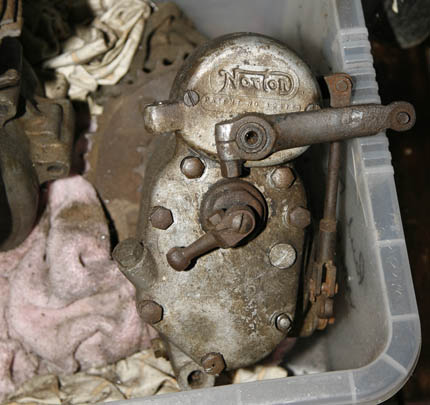
Pre-war type Manx gearbox is still unrestored. I have to admit, I have still to strip it down and check if it actually has a full Close Ratio cluster in it. However, if it hasent - they are now available. I am also considering having some of the Inter 'High Gear - Kickstart' first gears made shortly, which are those fitted to road going International gearbox's. Either ratio would be suitable for this bike - as I intend to have it road registered
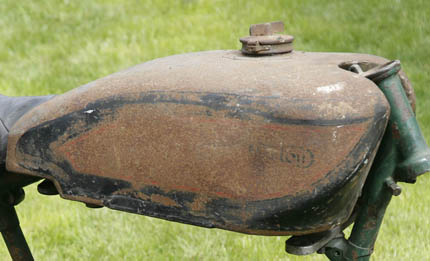
Wonderful time warp pre-war Manx tank is in rough condition - but still has the original factory paint lining and traces of dull nickel plating (not the silver paint we all use). Unfortunately - it has also had a hard life and there is a lot of superficial damage that will take some difficult repair work. The filler cap has come adrift and someone has put a strenghening plate around it. It has had heavy dents on both top flanks - which a good Norton friend and I were able mostly remove (thanks to his panel beating expertise). tank top clips have been removed - but can easily be added again.
Before restoring I will ensure I carefully trace the exact tank lining positions - as this must be one of the few genuine tank jobs still existing so I know they are definitive and correct. The tank looks like it is on steroids when compared to a standard 1930's International tank.
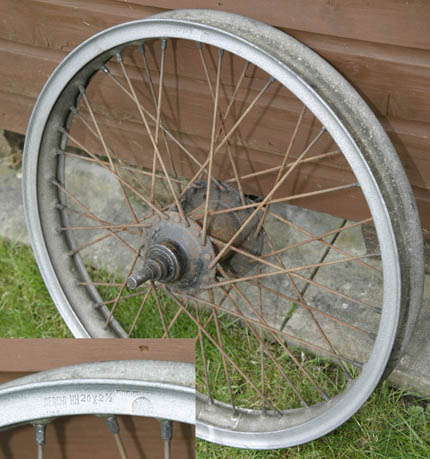
One of my favourite and most fortunate E-Bay purchases!
This is a genuine and original plunger Manx/M30 rear wheel, still on the original spokes and ultra rare Borrini/Rudge
20" Alloy rear wheel rim.
I have spent many years looking for these rare 20" allioy rims, which were the first alloy rims fitted to Manx Norton rear wheels in the late 1930's to late 1940's - and only have one other, and that I fitted to my Vincent Black Lightning replica.
Look at the bottom of the rim in the main photo and you will see these flanged rims (which proceeded all Borrini flanged alloy rims) have a plate welded over them to give them strength. Not also the other giveaway this was from a Manx/M30 spec motorcycle - the Plunger Norton rear hub (which on first sight looks relatively standard plunger Gardengate) has an unmachined timing side flange - while normal hubs are machined and have two slots in them to fit a Speedo drive. Therefore this is very early Manx Norton, probably pre-war . . . and the perfect rear wheel to fit to my 1938-39 spec Gardengate M30
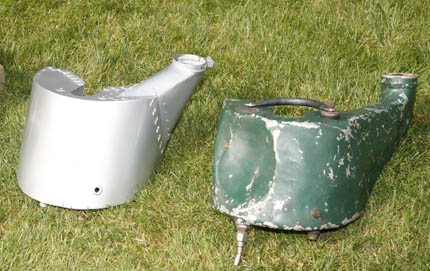
Oil tank on the left is reserved for this bike, alongside the aluminium 1950 tank for DOHC bike (see below).
Both are wrapround Manx tanks. the tank on the left is the type with a deep throat on the oil filler - not sure on the actual years, but I think the type before this had a less deep throat and more of an L shape neck
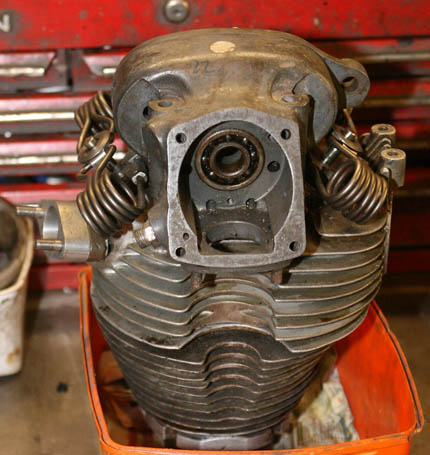
This was the 'round head' M30 top half I am using with our magnesium crankcases - this photo taken a couple of years ago - as you can see here, still unrestored. The barrel has now been blasted and been relinered (as shown in top photos, now mounted in crankcases) - ready to take Omega Methanol piston we also supply (Item 0686 from our catalog):
Norton Catalog - High Comp Alchohol Pistons
The head is my original spare racing head from the 38 Racing Inter, which is a pre-war bronze skulled alloy head with which I had the inlet tract bored out to 1.250" bore and a 1.855" inlet valve (about as extreme as you can go with a SOHC engine). Cambox at this stage was a nice original magnesium Manx cambox - but as I knew it was post war - have now replaced it with cambox in next photo -
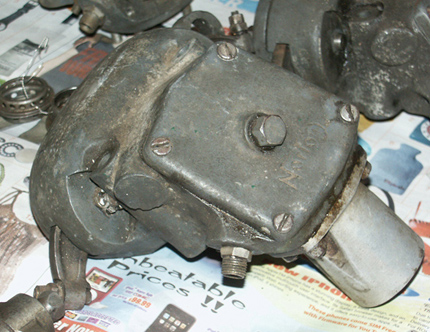
This Magnesium cambox is another one of the items I purchased from Arthur Moore in Australia many years ago. It came from an original pre-war M30 (Manx Specification) 500 racing engine - see photo below.
I could not afford the complete engine + shipping at the time (having already bought many other parts) and had earmarked another similar cambox, along with the green Manx chassis and many other parts. However, when Arthur checked this cambox as part of selling the engine, he realised one of the rear legs had cracked and asked if he could swap it out for the new Australian buyer for the cambox earmarked for myself - but
Arthur was kind enough to include a spare/bare cambox shell into the deal . . . knowing that pre-war Norton magnesium often will just not weld. For me this was fine - knowing I was receiving a very original untouched cambox, to swap out the shell . . . and if it did weld, then I might end up with a spare shell.
However, he did tell me that it was definitely untouched and original pre-war, and that when his family had purchased this engine many years ago - the previous owner had been told it may have been a 'Works' engine. I personally would doubt this - I dont know what the original engine number was, but know they were using DOHC on Works bikes by 1937'ish- but you never know . . .
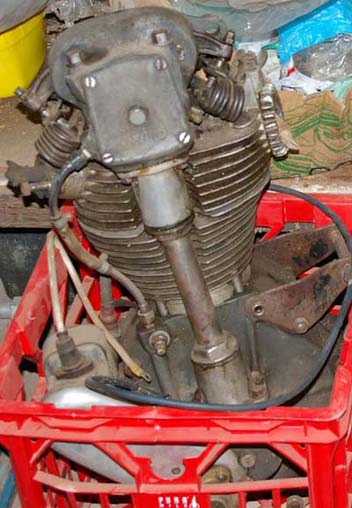
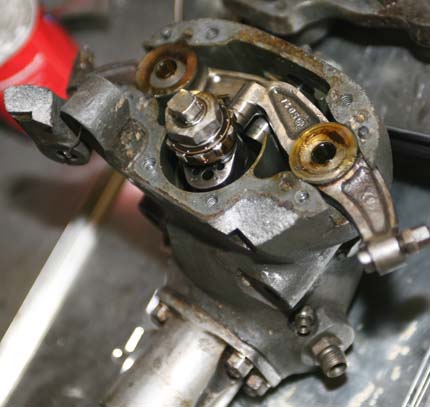
A horrible site for any SOHC Norton enthusiast to behold! - magnesium cambox with broken rear leg!
However, in this case that is how such an otherwise original M30 cambox came my way, and a spare cambox shell was thrown in with the deal, as the early Norton magnesium is very difficult to weld. This photo was taken in 2015 when I stripped the cambox down to try and repair the shell (or replace it) and rebuild it - as far as I know it is the first time anyone had looked inside it for at least 50 years (the photo of the original engine taken in Australia on the right showed the bike still had proper Manx engine plates fitted and looks like it had not been used since possibly the 1940s/50's. Other than the shell - the rest of the cambox internals were in lovely original and lightly worn condition. Click on photo to show enlarged version where you can still see the Longstroke Manx cam markings on the cam lobe. The orignal Castrol R had the consistency of golden syrup but had protected everything wonderfully
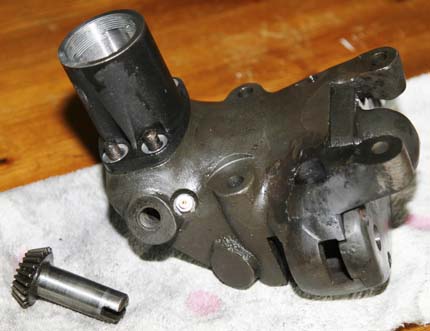
. . . .and is it turned out, welding this particular shell was just as difficult as we thought it was going to be! Initially I gave it to my normal (professioinal) welder of many years, who has done all my main castings for many years. He did this one back to back with another Post War magnesium shell (which I am ashamed to say was one I had inadvertently broken - the only time I had ever done this . . . I almost cried at the time!). But while the Post War magnesium shell welded beautifully, he declared this pre-war version to be 'electrified dirt' and unweldable! Certainly when he gave me it back you could see that the edge of the welded area had just turned to charcoal - Agghh!
So having resigned myself to loosing this shell anyway, I tried one last trick myself. I purchased some high-magnesium welding rods from the US (very expensive!), pre-heated both shell and broken foot as much as I could (while mounted on a steel jig I have for this purpose) and then attempted to TIG weld it myself - but with the amps on the welder turned up as high as I dared.
I watched the magnesium rods disappear at a tremendous rate, but as I hoped, I could also see the slag and impurities of the original magnesium being purged out by the high heat. The result is what you see here, after cleaning up, machining and re-chromating.
If you click on the photo to see the enlarged version you can just see some remaining bubbles of slag/impurities on the surface - however, I am pretty sure I got fusion to the main cambox . . . although it meant melting back deep into the main casting. I did give the foot a tentative clout with a mallet after welding and it did not flinch (even if I did!), so hope it will hold good. I will just need to remember not to put excess pressure on the feet when removing cambox in future. And the nice thing is - another original item resurrected
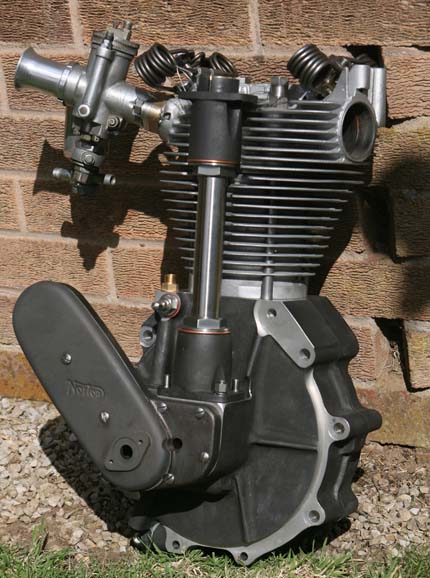
Another photo of the M30 engine, shown here just after we finished machining cranckases but had not rechromated them yet. This was to mock up bevel castings and head/barrel. It also shows the Amal RN carb I will be fitting
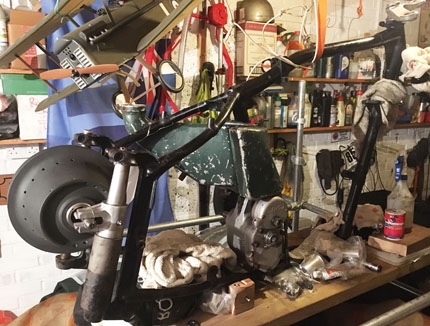
I am fortunate to also have one of the last Gardengate Manx chassis - made to fit a pre-featherbed DOHC engine. This is identifiable from other late 1940's Gardengate SOHC frames, as the bend in the top tube is very pronounced but further back than a SOHC tube - to allow for the extra length of the DOHC cambox casting. Although looking quite bare here - it does have the correct 1950 alloy long neck oil tank fitted (not yet restored) as well as alloy front tank brace and plungers trial fitted. As I write this update in Spring 2019, I am in process of having plunger springs manufactured from original patterns - which are actually from a Manx (but shold be same for all)
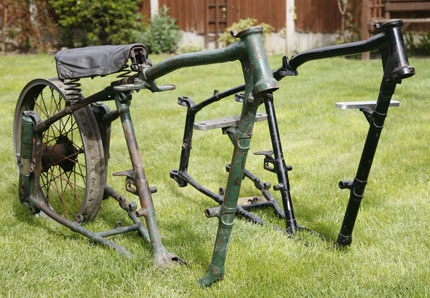
A great opportunity to see two genuine Gardengate Manx frames side by side - which shows clearly the difference in top tube detail. The frame on the left is 600cc SOHC Manx - so it does have a pronounced bend, to allow for the tall 600cc engine. However the frame on the right has a bend much further back to clear the DOHC cambox. If you were to place a 500cc Manx frame alongside the tube would look much straighter. There were a couple of 600cc DOHC frames made (one being for Eric Oliver), I have seen one of those frames and the bend was so pronounced it looked like a Helter Skelter fairground ride!
For anyone trying to identify genuine Manx frames - both these frames have the definitive specification, which is different to both International and OHV Gardengate frames

This is the engine currently in the 1938 Big Plunger, just after I rebuilt it, and with a magnesium SOHC fitted'. However, as I mention above in the Big Plunger section - I now have a more correct 350 pre-war engine to go in that bike, and this engine bottom half was originally supplied to Les Archer in the late 1940's and is more correct to go in the 1950 chassis - hopefully with a DOHC cambox replacing this SOHC version
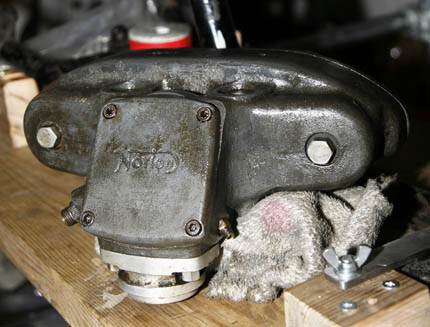
This is actually a recent addition - purchased in 2019, but as I am intending to fit a DOHC cambox to the engine that goes into this frame - this is a very likely candidate. It is actually the later type of cambox (the shortstroke type) rather than the first Longstroke production type that would have originally been fitted to a 1950 engine. The main difference is that on the early type the rear feet were cast into the main cambox shell while this type had the rear platform cast into the rear cover, as well as mounting the rev clock drive from the cambox as well (which this one has). This cambox was purchased along with another very similar one at Bonhams Stafford auction and came from a big collection of original parts. From its overall condition and boxs that came with it - I suspect it has not been touched since the 1960's. Still need to check it out inside and it will need pusher bearings replaced.
Wanted - early DOHC Cambox
Athough these cambox's are very original and nice condition - I would be interested in swapping one of them for the earlier Longstroke type-in similar condtion. Email me at paul.norman@racingvincent.co.uk if you have one to sell or swap
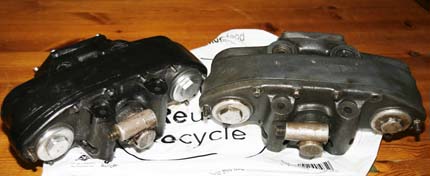 This is another photo of the DOHC cambox (on the right), along with the second similar cambox I purchased at the same time. Both are the later type with rear mounts built into the rear cover
This is another photo of the DOHC cambox (on the right), along with the second similar cambox I purchased at the same time. Both are the later type with rear mounts built into the rear cover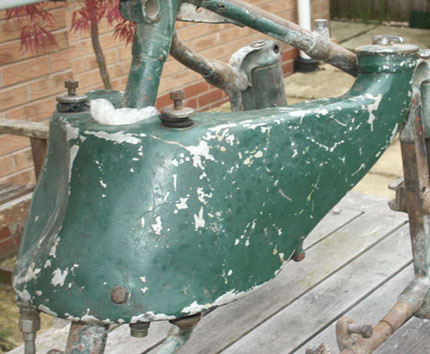
Another shot of the 1950 alloy oil tank - this photo taken some years ago, when bought back from Australia with 600 frame. They were both painted green, so maybe this tank was fitted to the 600 frame in its last years of use. Unfortunately it too will need some restoration work, as on the timing side of the bike someone had stoved it in purposefully - I assume because it may have been fitted with a 350 engine when last raced, and the carb probably fouled the oil tank here. I will need to very carefully open a panel at the back and planish out the worst of the dents. No doubt it will need to go into our oven for a while before I do that - to anneal it, but sure my wife will be accomodating as ever! Note all the fittings, all original - including the perished bolt - thru 'Top Hat' rubbers used on the 1950 alloy oil tank.
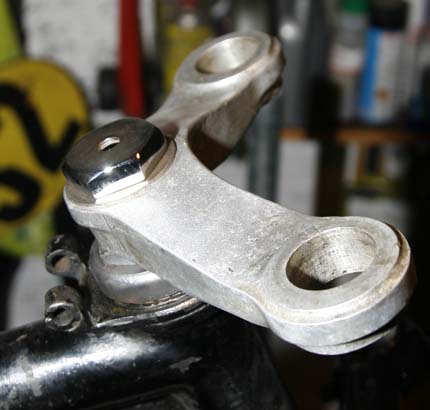
A lovely and not so obvious item I have been holding back for years.
This is the type of Manx head yoke fitted to the Featherbed Works bikes in the Joe Craig era of Ray Amm, Geoff Duke etc - identifiable by the strenghening ribs around the stanchion tube areas.
I have compared this one side by side with a genuine Works item, and there are minor casting differences underneath. Although it could possibly be Works, I think it is more likely to be a Beart item - he was making a number of alloy items for Gardengates and early Featherbeds at this time
Regardless - I think putting it onto a 1950 DOHC Gardgengate is a nice way for it to see the light of day again and should be a real point of interest
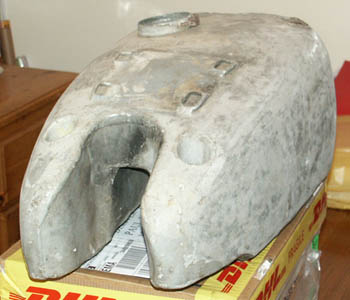
I am alsoy fortunate to have a genuine 1950 alloy Gardengate Manx petrol tank - only fitted for one year. Again, this was bought back from Australia, along with the green Manx Frame - and originally thinking of fitting it to that bike, but more correct to fit it to this bike. Again, as you can see from photographs, a lot of restoration work to do when ready, it is split underneath and the chinpad tabs need pulling out as they have been knocked almost flush to the tank top.
Still a great tank to have though and will look good when painted and re-lined
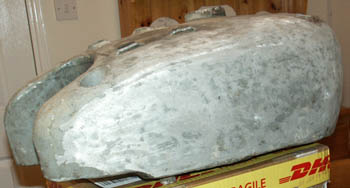
Another view of teh 1950 tank, in side profile - showing the very deep drop at the rear - more so than Gardengate Manx tanks of earlier years. Underneath on each side this tank has had a panel removed (as well as the baffles) - so that it all the dents it had accumulated when racing could be knocked out. I am not sure if it was my old friend Arthur Moore who did this - or a previous owner, but they seemed to have done a good job. I dont think there is much re-shaping of the outer profile needed - but baffle plates will need to be put back in, the bottom plates re-welded and the rear splits welded - all possible and part of the satisfaction of restoring an original and rare motorcycle part
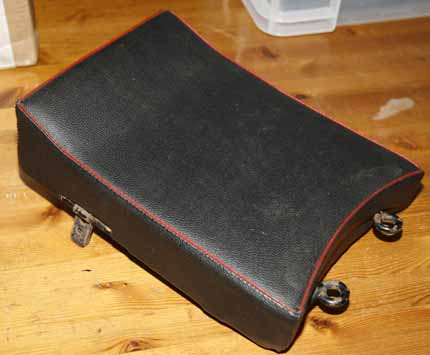
Perhaps the only one of these left in this condition? . . . 'New Old Stock' Gardengate Manx rear mattress. I have been holding this fantastic time warp item in a box for many years, waiting for the right bike to put it on to. Originally I was thinking of putting it on the sidecar outfit - but don't really want a passenger climbing all over it!! The 1950 Gardengate will be perfect for it
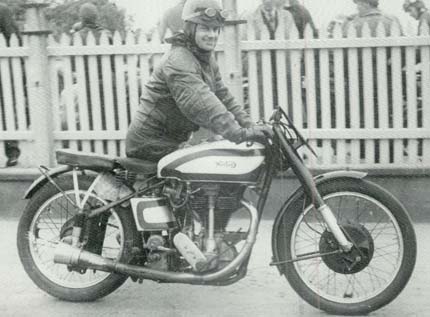
Period shot of the late Phil Heath on another 1950 Manx Norton. Click on photo to see larger version - this photo of Phil at the 1950 TT show all the identifying features of a 1950 Spec bike - alloy fuel and oil tanks, conical rear brake (which I also have), and the big flange type conical front whee (which I dont have - in case anyone has one for sale!). I think this is also a DOHC bike, although more difficult to tell.
Incidentally, if anyone out there has a photo of Phil Heath on his HRD Vincent in the 1948 Clubmans TT I would love to hear from you. I think the engine unit of that bike is the one in my own HRD Lightning Rep, but do not have any original photos of the bike and cannot find any. I used to know Phil well but only found about the Vincent connection after he passed away
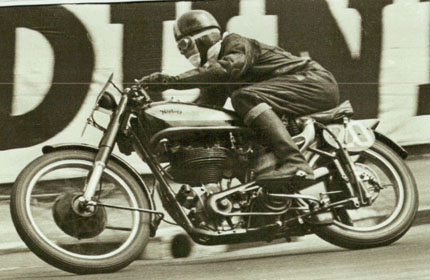
And another shot from the 1950 TT - but this time it is Les Archer, also on a 1950 Gardengate - and click on the picture to see a larger version where it is clear this is a DOHC bike. I would love to think my crankcase-engine is the same engine, but from the engine number and what Les himself told me, I think my engine is from an earlier bike than this one
.jpg)
I was very fortunate to have accompanied Tich Allen to all kinds of meetings over a 20 year period.. In that time we road raced, sprinted, grass track raced and sometimes just watched - but it was always good fun - Titch being young at heart and still loving bikes well into his 80's.
I was proud to have been his passenger (again!) for his very last ride at the age of 91 at the 2006 Festival of 1000 Bikes on his Manx framed 'Posing Outfit'.
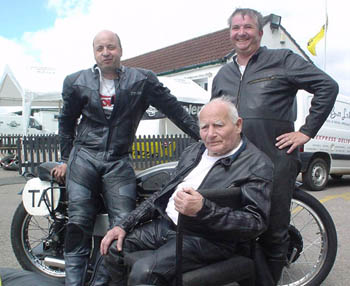
At the same meeting, with Titch and his younger son Steve Allen - an accomplinshed sidecar rider in his own right, and someone I have also passengered for over the years. As well as riding with Titch, Steve and I also had a good ride in the sidecar event - a great day.
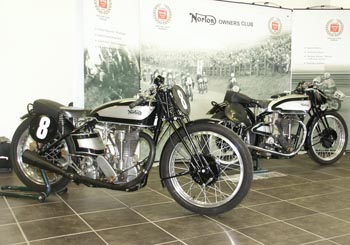
This photograph was taken at Donington Park where the Norton Owners Club had their 50th Anniversary Meeting. I felt priviledged to be asked to display some of my bikes in their main display area on the Sunday
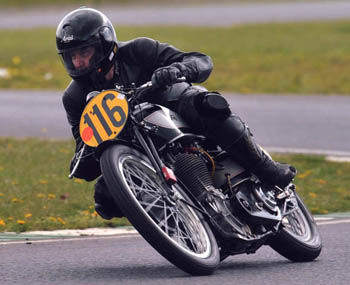
Above: Rare competitive outing at Mallory VMCC meeting. This is taken just exiting Edwinas chicane in April 2012 on my 38 Racing Inter
.
Below: As an interesting comparison - hard to believe, but this is the same piece of track 20 years before!, a photo of a much younger me, going through the old Mallory Esses, which was there before Edwina's. Think this was early '90's Post TT. Bit slimmer then . . .
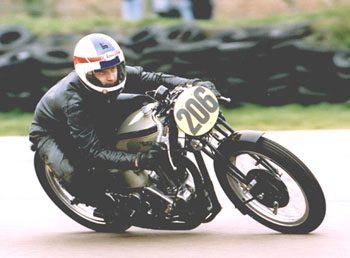
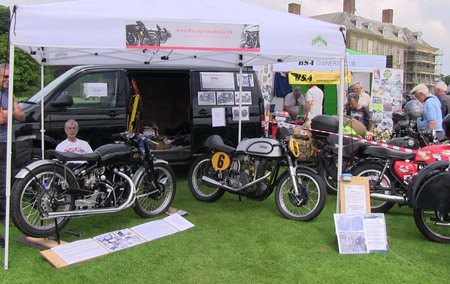
Stanford Hall VMCC Founders Day 2014. This is one of the oldest established classic bike rallies (i remember going as a boy in the early 1970's with my father!). I do not normally do rallies, but they said it would be nice to see the Vinnie and make some noise with one of the Nortons, so they offered me a club stand. My good friend Andy Kirk is behind the Vinnie, with the BSA Clubstand next to us and the Hall in the background - lovely laid back day
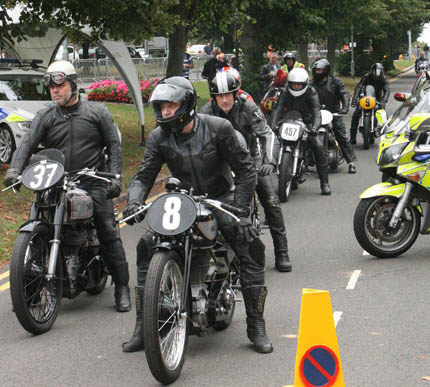
Brackley Bike Festival 2011
This was a most unusual and entertaining day out. Along with other members of the Norton Owners Club - we had had an invite to attend this meeting - where the whole of Brackley town centre had been turned into a motorcycle carnival for the day. As well as motorcycle enthusiasts of every type, almost all the town locals had turned out, with all kinds of displays and stands present. Here a number of us are waiting to be ushered onto the closed off main High Street to make some noise for the locals! Notice our own Police envoy.
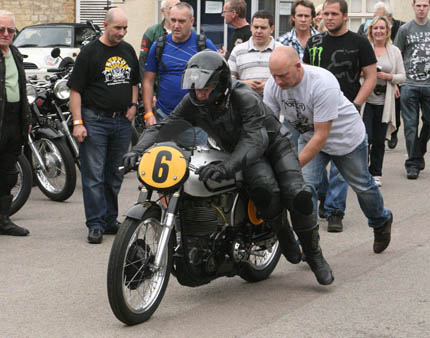
Same Brackley meeting and I took two bikes - the 38 Racing Inter and here, bump starting the 55 DOHC Manx with the help of fellow cammy Norton enthusiast Neil Ford.
I did not have the Solo bike rollers then, and trying to bump start a race Norton on high first gear in a side road with members of public and their children just walking around you was a bit scary. At least they got out of the way and soon as the bike fired up and they heard what an open Megga sounds like!
I did a short article on the meeting at the time, click on the link:

Looking very much out of place - as the solitary pre-war race bike surrounded by mostly 1950's-60's Classic bike brigade, this was a Mallory VMCC Practice Day in approx 2012'.

And here another photo of the same Practice Day - although a different session. The helmet looking down at his bike is another pre-war bike - Phil Cramp on his Velo.
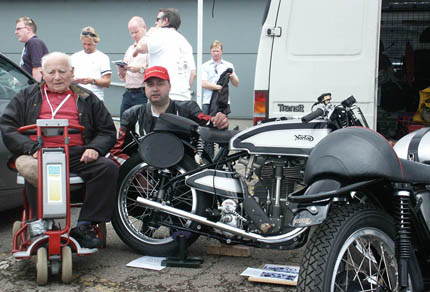
This photo goes back to 1000 Bike Festival 2009, and what turned out to be Titch Allen's last public event - he went into hospital shortly after this was taken. I rode the 1955 DOHC Norton at this event and remember having an excellent session following Keith Heckles on his Beart Norton. I also remember thinking the bike was going quite well round Gerards in an earlier session - when Mick Grant went past me like I was standing still on the Kawasaki Green Meenie!, Hey ho. Notice person in background looking down is a certain Carl Fogarty
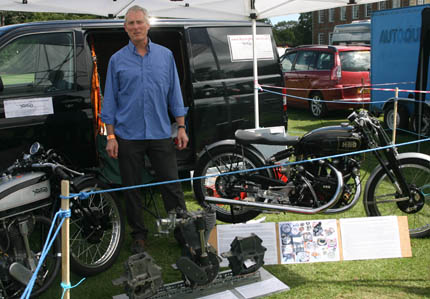
Stanford Hall Founders Day again - this time 2015 and we had a small stand. In this photo is Rob Norton. Rob and I grew up together and many of my earliest rides were with Rob on a variety of bikes. Rob was a CNC machinist in the aerospace industry and machined our M30 crankcases
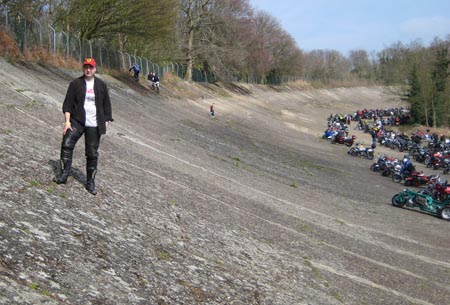
For anyone not familiar - Brooklands is the oldest (and arguably most famous) purpose built race track in the UK, being built and opened in approximately 1909. It was most well known for its amazing banking with huge behemoth racings cars running round it at amazing speeds for those pre WWII days.. It closed to racing at the outbreak of the second world war (1939) - never to repopen to competitive racin, its track being partly built over for the war effort.
Now, very much like a time capsule, parts of this historic track, set in the urban sprawl of Weybridge Surrey still exist in dilapadated and overgrown state - which just adds to the amazing atmosphere. This photograph taken in 2008 shows how the original concrete banking looks today
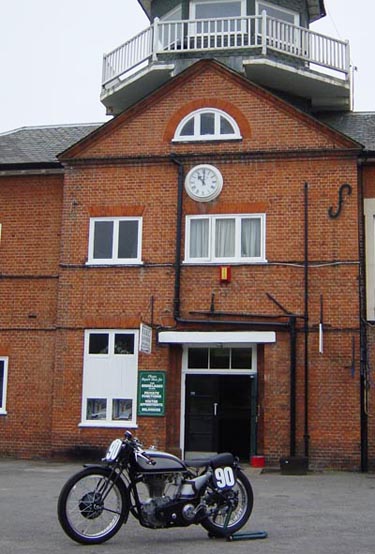
I think this was first visit for the Racing Inter at Brooklands - 2006
Here photographed outside main Clubhouse at start of day
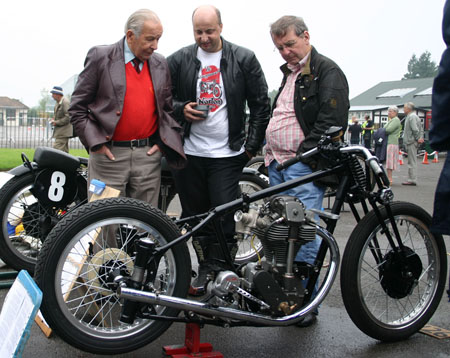
2008 and I took the 1938 Big Plunger Manx to Brooklands (as well as my Racing Inter), when not yet finished. Shown here talking to legendary Works Norton mechanic (from Joe Craig days) on the left - Charlie Edwards, and his son on the right, who was still doing the occasional race on a Norton when I first started racing in the mid 1980's. Charlie was still able to point out all the bits that did not look right!
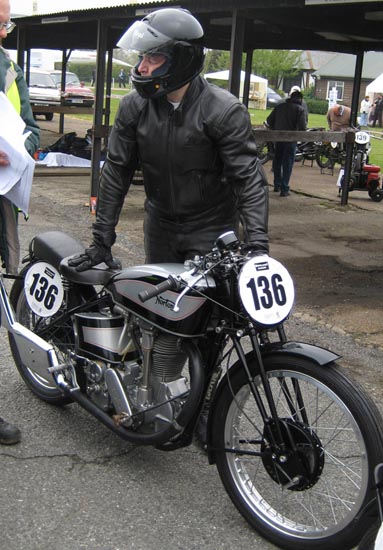
Above: Same 2008 Brooklands meeting - Brooklands can fitted to Racing Inter for the day - although by the afternoon session on the Mercedes test track, I had removed it and fitted the far more fruity Megga for effect
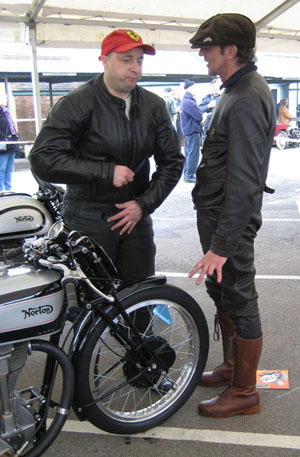
Myself pulling a face while holding my breath and trying to get the zip passed by ample gut - while George Cohen asks if I have indigestion?!
(Norton) George and I had spent the last 30 years occasionally meeting up - I first met him when we were both hunting through boxes of old Norton gears at a Stanford Hall meeting in the late 1970's - both looking for the same CR ones
Unfortunately George passed away recently, I went to see him in his Edwardian workshop in his last few weeks - George was a real character, sadly missed
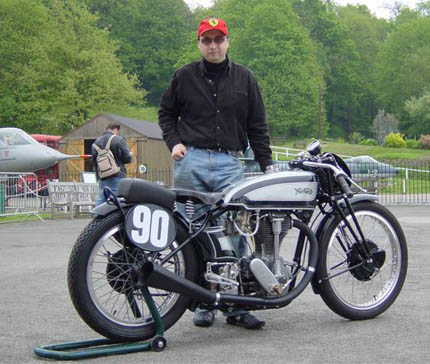
Another photo of an earlier visit - this being 2006. Note Harrier jump jet and Hawker Hunter in the background
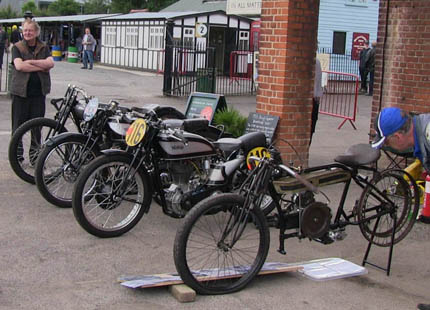
My last visit to Brooklands was in 2016, where I took the 38 Racing Inter and the loosely cobbled together Douglas in unrestored condition - but it looked the part - a very similar bike having taken the 1912 Junior GP at Brooklands, and mine looking like it had just been pulled out of a local barn unrestored since then! See the link lower down for a seperate article on this meeting
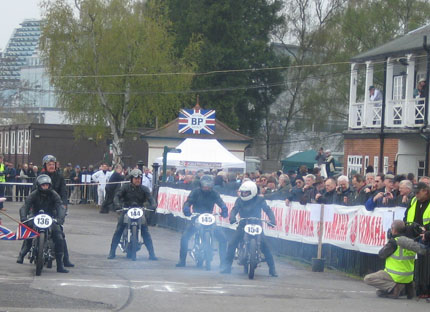
Another photo from 2008 Brookland (Motorcycle Centenary mtg?) with a haze of Castrol R from the paddock area and a group of us about to do some laps up the Test Hill and around the banking. Spectators look down from the Clubhouse on the right
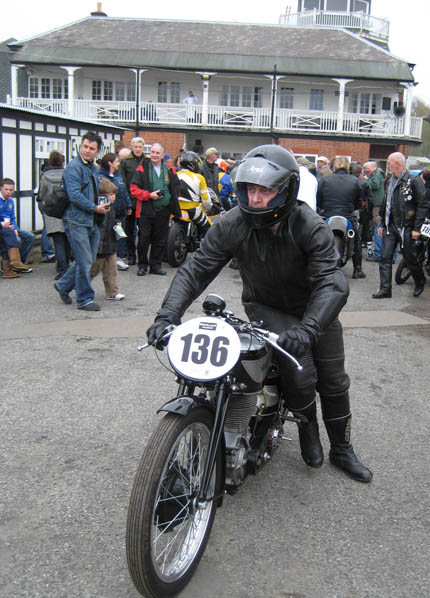
Lovely view of the Brooklands clubhouse in the background. Whenever I visit Brooklands at Weybridge, Surrey I am reminded of a bygone age - and it is just like being in a little oasis of the 1920's-1930's, great stuff!
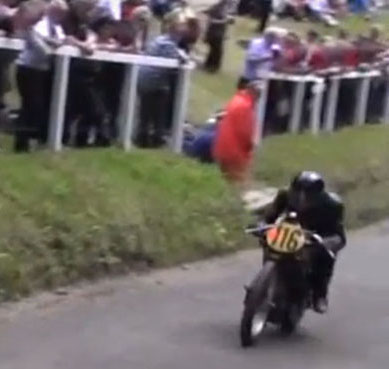
Almost an action shot! - Ascending Brooklands Test Hill on full chat in 2016
In previous years gone by I had got into trouble for not shutting off soon enough and getting it a bit airborne at the top - but that was standard procedure in Brooklands heyday
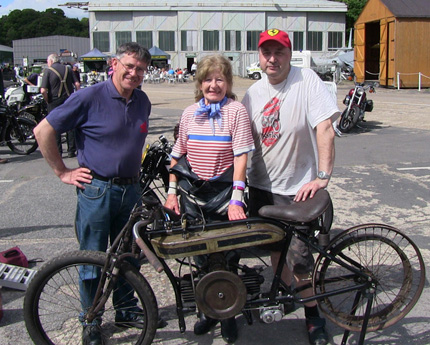
With old racing firends - Richard Cornish on the left and Sheelagh O'Neill in the centre. Brooklands hanger in the background. This photo taken at the end of the day, when just loading the bikes back into the van - a nice opportunity to meet old friends and chew the fat
The next set of photos are of my 1948 Vincent Black Lightning Replica, most of these been taken shortly after completion in Summer 2014
I first purchased this bike wasy back in 1988 as an incomplete basket case, but it came from a well known and respected Vincent family and all the main castings and parts were in excellent condition. The basis for the bike is a very early 1948 Rapide (some Vincent people feel the early crankcases such as this one were the best quality - these ones certainly looked excellent and were one of the main reasons I purchased the bike).
I have subsequently found out that the engine was possibly from the Rapide that came 2nd in the 1948 Clubmans TT, ridden by an old friend of mine, the late Phil Heath. I wish I had known this while he was alive as I would have loved to ask him about the ride and if he had any photos of the bike - I have subequently scanned the web and been unable to find anything (if anyone has a photo - I would dearly like to see it).
The intention was always to build the bike to as close to original Black Lighntning 1948 specification as possible (as per the 48 Catalog picture), however, in the early days I built the wheels over more modern 18" alloy rims and big Classic Racing race rubber - with a view to racing it in VMCC pre-58 Unlimited class. Since then my views have changed and more recently I rebuilt the wheels to the original rims size - 21" front and 20" rear, using a rare original 20" rear alloy rim.
I am pleased to say the final build has come out as close to original Lightning spec for that year as I am likely to be able to achieve - with quite a few genuine Lightning parts, or new parts to Lightning spec
Inside the engine it is fully rebuilt to Black Lightning specification - rebuilt and balanced Maugan crank and racing Big End ( with the inclusion of more modern updates like Carillo conrods) 32mm tract flowed cylinder heads, lightened steel idler wheel/cam wheels, 2A cams, slipper pistons, Lightning clutch etc.
The machine took over 20 years to build - mainly because other builds and racing got in the wasy, but I got it finished back in 2014 at long last. Since that time - due to other projects and the business getting in the way I have not had chance to run it properly - but sure I will when I get more time . .. it is fully built and waiting for an airingl.
By the way, this was the subject matter for the original Racing Vincent website, and all of those original articles are still available by going to my 'Articles' web page.
As a final point - I am looking for a Steib S501 (or possibly even S351) sidecar to purchase - irrespective of condition, to go with this bike. i was thinking - with a sidecar I could probably fit an electric starter and put the battery in the boot of the sidecar - could be a very sporty and unusual road bike!
As always - 'click' on the photo for a larger version - and some of these are big enough to be used as screensavers or wallpaper
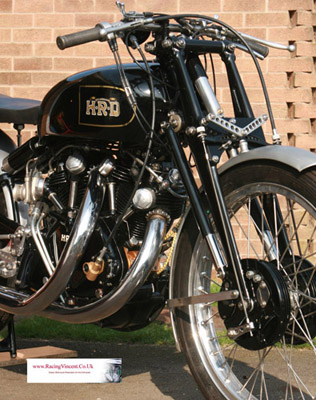
This photo shows front Girdraulic forks and twin ribbed brakes with the racing 'scooped' brake plates, fitted to Black Lightning and Grey Flash models. Front brake balance beam hanger was an almost obligatory mod, to reduce sponginess
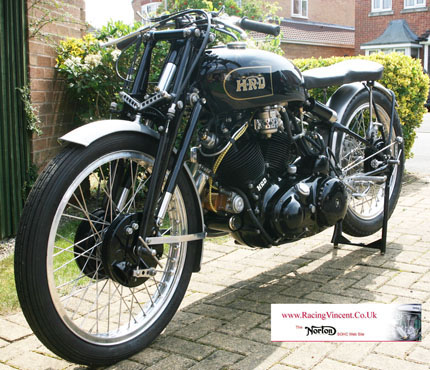
Drive side of bike, showing KVFTT Lucas racing magneto and large (soft mounted) remote TT float chamber
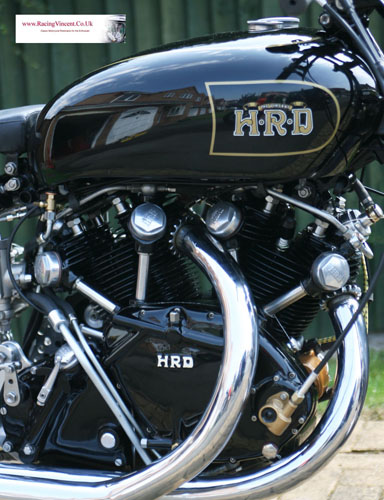
Big Vee Twin Engine Lump - at full Lightning spec on the inside, with Carillo rods, balanced crank, 32mm inlet tract ported cylinder head, twin speed oil pump, lightened timing gears, high compression pistons and MkII cam profiles
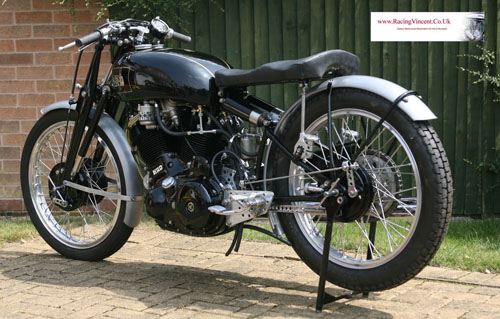
I particularly like the stance of the bike here - taken of the drive side, I think it shows the Black Lightning at its aggressive best.
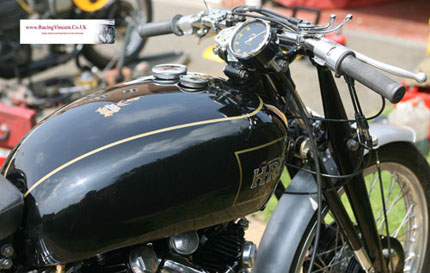
Petrol tank lining is based on the early HRD style - with factory photos used for reference, with the lining coming in at the rear. The bike is based on the first 1948 Show Bike
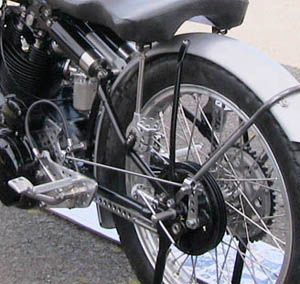
This photo shows the rear brake linkage particular to the Black Lighting and Grey Flash racing models. I have fitted sprocket carrier on this bike - a common mod, as twin rear brakes not essential, and reduced weight for racing
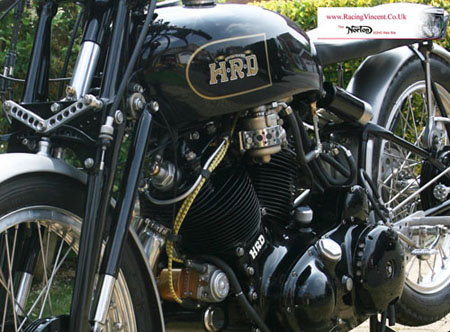
Another drive side picture. Look closely and you will see many nuts and bolts lockwired. Look at the photo below of the TT carburettor, without tank fitted and you will appreciate how big the petrol tank cutaway is compared to standard Rapide
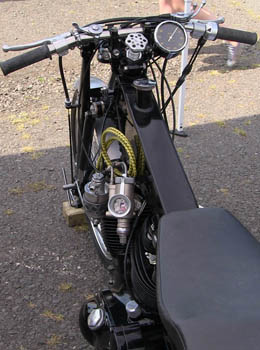
Top view shows big 32mm racing carb bellmouth. Note also rev clock fitted - which has correct yellow numerals - particular to the Black Lightning
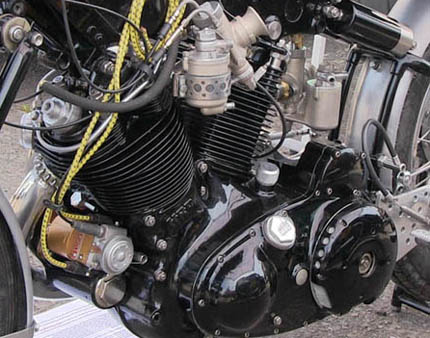
Taken before completion, this photo shows some engie detail.
Magneto is a KVTT Lucas racing magneto (only made for this bike), while drilled clutch cover (to aid cooling - not lighning) hides an original Vincent (not modified) clutch to full Black Lightning specification
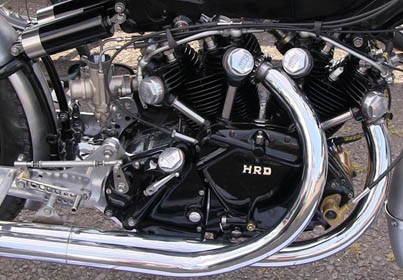
This engine shot showsf the classic lines of Phil Vincent's masterpiece well.
Although this particular engine was originally a Rapide - the VOC Registrar informed me that the number shows it being from the actual bike that Phil Heath rode to 2nd place in the 1948 Clubmans TT, so it does have competition history! The late Phil Heath was an old friend, but I did not become aware of this until after his death, as it would have been great to have talked to him about that ride
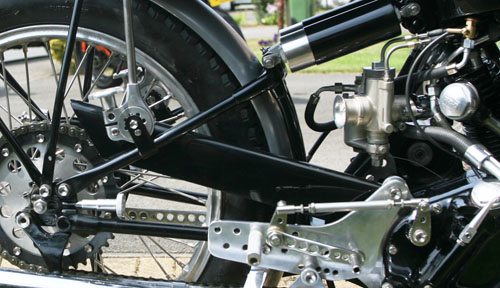
Showing the gear linkage mechanism and hanger plates - these being particular to the Black Lightning and Grey Flash models. Note also 'Series B' style RFM and my normal weight reduction of various fasteners and other parts. Incidentally, the lightening of the rear damper units was copied from a factory photo of the first 1948 Lightning catalog picture
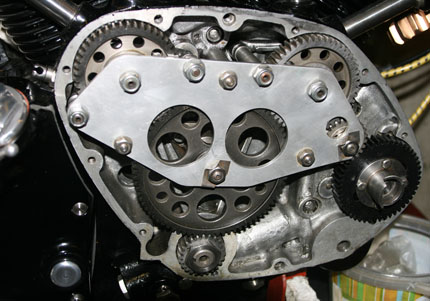
Inside, the engine is pretty much at full Black Lightning specification on the inside - as well as most of the consumable items having been replaced or refurbished as part of the build. The timing chest is a good example of this. Many years ago when I first started the build I sold a couple of other bikes so I could replenish everything that needed it and put the best of everything in it - most of it from Maughans, top quality Vincent engineers. As you can see, cam wheels are lightened - with racing profile cams welded to the wheels after setting. The idler wheel is also a steel racing wheel, of slightly slimmer profile than standard. Black fibre gear is to the KVFTT magneto and has a rev clock drive fitted to it
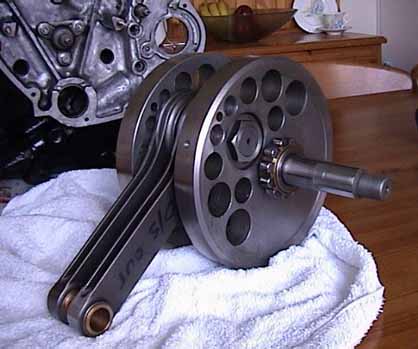
Similarly - the crankshaft also got a lot of attention and was one of the first major lumps to be built - if I remember correctly in the mid 1990's. As well as fitting Carillo conrods, the flywheels received new mainshafts from Maughan's, was rebuilt with racing Big End, then the flywheels lightly skimmed, and finally - statically and dynamically balanced for the pistons that were fitted
Another Vincent in our family is a very original Comet that my father bought way back in 1960, and in many ways was the catalyst for my enthusiasm for this marque.
I can remember from the very earliset age listening for the distinctive crack of the Comet exhaust, which signified my father coming home from work - so this model is very close to my heart. Although always considered the 'poor relation' to the Vincent Twin, the Comet (and rarer Meteor) was actually a very nice bike in its own right, and no slouch either. I well remember working on this bike with my father as a child and can remember how easily it could be taken apart to work on. I also remember my father constantly struggling with the Miller electrics - and eventually resigning himself to fitting a common mod - a Lucas rectifier!
When I restored the bike in @2013-2014 I found myself retrospectively putting back the shitty Miller electrics, which I am sure would have made my dad laugh. well, at least they look like the original electrics - but the original Miller regulator box hides a modern
solid state unit, the dynamo has been treated to new windings and brushes and rear light and dipswitch are modern replica's - as the originals were too broken and tired. It is now in regular 'Sunday ride in the country' use, and when sat in my garage makes an interesting comparison with the Honda CBR600RR sat next to it!
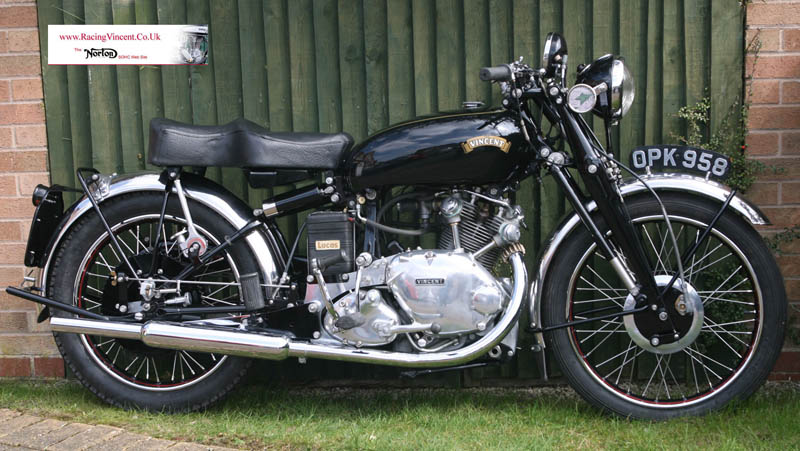
1950 Vincent Comet - Has been in our famil since 1960, my father and then myself. I restored it as seen here back in 2015
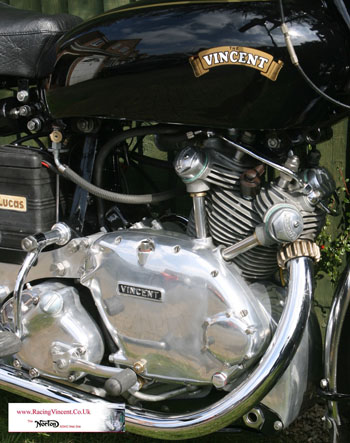
The Comet was restored in 2014-15, but trying to maintain as many of the original parts as I could - I gave it new valve gear and cam/cam followers, as all were worn - but the Bigend was still in good nick, I remember fitting it with my father in the early 1970's!
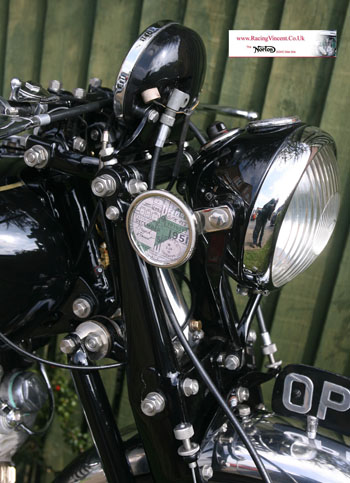 Maybe my favourite photo - I like the 'Business' of Vincent front forks - and will all spindles and lower eccentrics replaced they now work pretty well as well. Stainless fittings all over. Tax disc I decided to nickel plate - and fit period tax disc as would have been fitted in the first year of its life!
Maybe my favourite photo - I like the 'Business' of Vincent front forks - and will all spindles and lower eccentrics replaced they now work pretty well as well. Stainless fittings all over. Tax disc I decided to nickel plate - and fit period tax disc as would have been fitted in the first year of its life!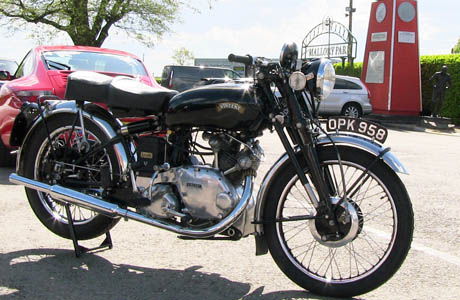
2017 and one of my first runs out on the Comet after its rebuild - and as you can see from teh gates in the background - parked in the car park of Mallory Park race circuit, one of my favourite Sunday afternoon short rides
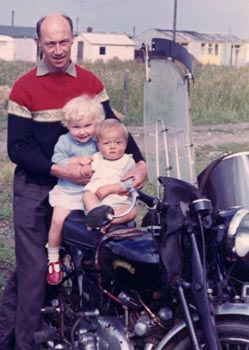
And here is a photo of the Vincent in its earlier days in our family. The ugly little urchin in the front of the photo is myself, sat on the Vinnie back in 1963, with my father and sister behind me. The Comet was attached to a Blacknell Bullet sidecar at that time - wish we still had that now as well!
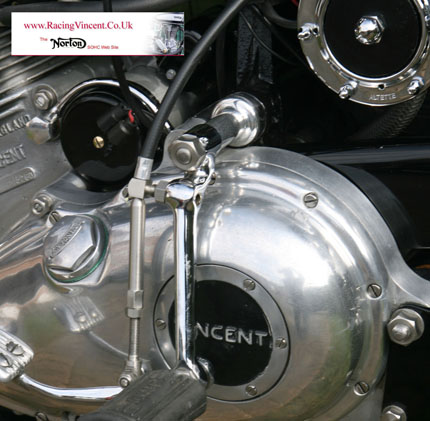
Clutch side of the Comet, shows rear brake assembly. All original parts were straightened up and rechromed, but brake cable assembly and fastenings mainly stainless steel. Dynamo was rebuilt and electoic regulator fitted inside original Miller regulator case
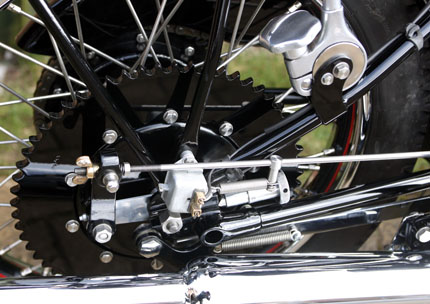
Rear wheel retains orginal Vincent sidecar sprocket as well as solo sprocket - note Vincent part no stamped on it in top left of sprocket. Rarely seen these days - but I remember in the '60's many owners had two sprockets fitted and sometimes fitted a chair for transporting the family
The final Vincent is this long term build of a Vincent Grey Flash - the road racing version of a Vincent Comet, of which Vincent's only made approximately 20 machines between 1949 - 50, but many replica's have been put together since!
As a teenager I often pestered my father, asking if we could consider building one, using up a number of spares he had - including UFM, engine, forks etc. Although we talked about it a few times, we never got round to doing it - but it never stopped my desire to one day build one of these rare Vinnie racer's with the unusual grey paint finish. Particularly the main parts I did not have was a rear swinging arm (RFM) and the racing Albion box particular to this model.
Skipping forward many years, although genuine Grey Flash or (or any original racing Vincent parts) have been few and far between, and because this has been a 'back burner' project - with what little cash I have had always reserved for s always another, more urgent project, it has been slow going. But thanks to a 'growing spurt' in the md 2000'teens, I now have the majority of the parts I need - including a nice quality Comet RFM and that all important Albion racing gearbox.
I now just need some time to start on the 'build' of this interesting project proper - whcih no doubt will get covered in a future article. The intention will be to build it close to original spec and look - but i will probably use the 18" alloy rims and competition chewy rubber I originally bought for the Lighting wheels, so I can use it for the odd twisty sprint. Below are some photographs of parts accumulated, and a link to an article I wrote back in
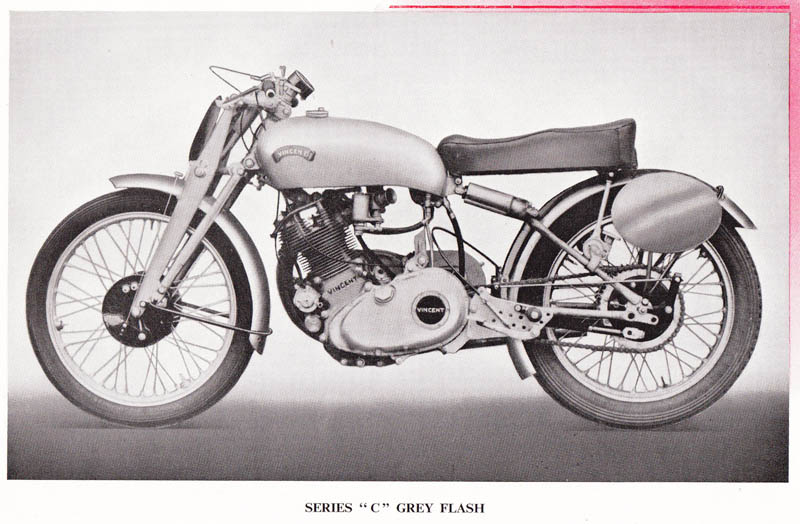
Vincent Grey Flash factory photograph. Many of the differences between this model and a standard Comet can be seen here - magnesium brake plates, TT (or RN) carb, BTH magneto, alloy wheel rims, rearset footrests on different hanger plates, and the different gearblox outrigger plate can just be seen
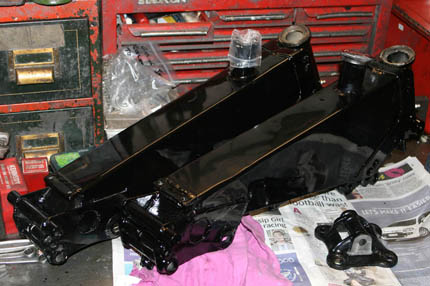
I have had a spare Vincent Upper Frame Member (UFM) reserved for a Vincent Grey Flash Replica ever since I was a teenager. I first talked about building one with my father long before I was old enough to ride, using up many of the spares he had accumulated from owning two Vincents in the 1960's, when spares were a bit more plentiful. Eventually, I did a swop with him for this UFM and a spare set of Girdraulics that will also be used for the GF Rep.
This photograph was taken about 10 years ago when I was preparing the Black Lightning Rep UFM for fitting and had the other UFM out for comparison. Although painted black here (I had some surplus black at some stage - so gave it a coat of paint), eventually it will be checked over again and painted the distinctive dark grey - associated with a Grey Flash. I have seen other Grey Flash's where the headstock is drilled for lightness - not sure about this yet?
And here is the associated Rear Frame Member (RFM). How I came by this is covered in another article I did on the Grey Flash build - but it was a far more recent acquisition, and as it had taken so many years to be able to find/afford one - was one of the main reasons I did not pursue building one as a teenager. However, all good now and this is a very nice straight and orgiinal Comet RFM. Again, I need to give some thought if I lighten the main swinging arm casting - as these were often drilled. It is likely that I will do this though - they look much better for it and saves a bit of weight. Again - once done the RFM will be painted grey
Link to previous Vincent Grey Flash article is below
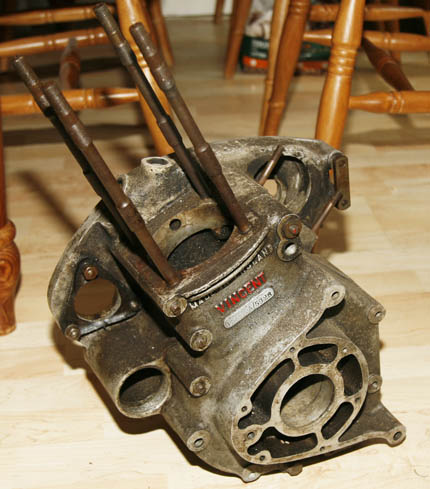
Because I have not really started on the rebuild of the 500 Grey Flash Rep yet, I have not really given the engine parts much examination - but this is one of two sets of 500 Comet crankcases I (think?!) I have to use. The reason I say that - I packed away a few years ago all the engine parts - but seem to remember, I pretty much have a complete Comet spare engine - and I think another spare set of crankcases, which are these. I believe my father bought these as spares in the 1960's and they seem pretty solid and complete. Vincent crankcases are beefy anyway, and I have not heard of anyone managing to split a set of Comet crankcases when racing! I have much of a rest of an engine stashed away as well for when I start building this project bike in earnest

Similar to the crankcases, this is a Comet (i.e. a front head - with the inlet tract facing to the left side) that I can remember being in the family since I was a kid - and very much describes my father's (and my) genertion - i.e. don't throw anything away!! My father told me that many years ago in the 1960's he asked someone where he worked - British United Shoe Machinery in Leicester, if they could weld up the spark plug hole of this Vincent head (I assume the thread had gone). Unfortunately the welder looks to have 'gas welded' the head and this rarely works well, in this case you can see most of the head looks to have dissolved and now looks like honeycomb!
The head was lucky not to end up in skip . . . but nowadays Vincent front head's are rare commodities - and I think with modern TIG welding I could build this head back up, and maybe build the chamber to give it a 'Squish' head for the Grey Flash, as well as big inlet tract and inlet valve
And If things dont work out well - I do have a better standard head with the main engine
I purchased this racing cam and followers off Ebay, but found out they came from an old mate and gather they came out of his Grey Flash which was very fast. I believe they are Terry Prince items. There is some wear, and followers could do with stoning, but look usable for the Grey Flash engine
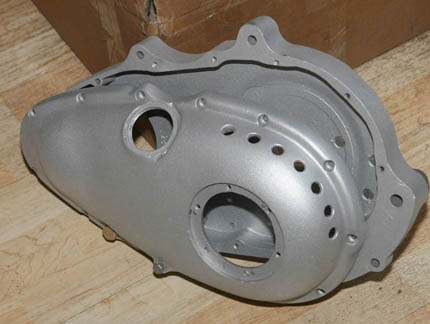
Primary inner and outer chaincase for the Grey Flash Rep. The rear chaincase on a Comet is also the swinging arm pivot so is quite important.
The front chaincase is often seen removed on period shots of Grey Flash's being raced, to give better access to chain and probably cool the clutch.
However, I prefer the lines, when the primary chaincase is retained - and doubt I will be using it that seriously! However, I have adopted one of the other period mod's for a Grey Flash - to add cooling holes, as shown here.
Both chaincases have also been blasted to give a satin alumium effect, which was another feature of the original Grey Flash model - with all main engine and transmission castings having a similar finish
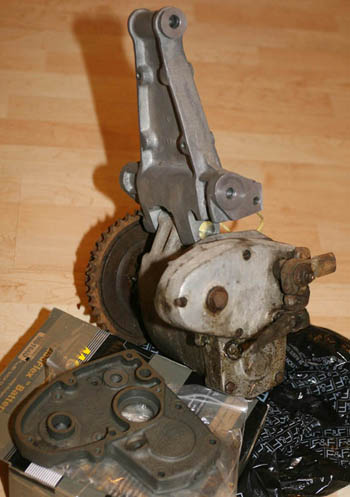
Probably the hardest to find item for any proper Grey Flash project bike - the all important Albion Model 5 H Type racing gearbox. And with this gearbox a different F106/1 vertical outrigger casting was also fitted the Grey Flash model. As you can see I have also managed to acquire one of these
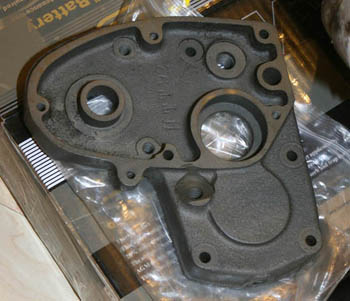
And all the way back from Australia I have also been fortunate enough to acquire a genuine magnesium TT gearbox cover - shown here having just been blasted and re-chromated. I am still looking for the corresponding magnesium outer cover if you happen to have one sat in the back of your garage!
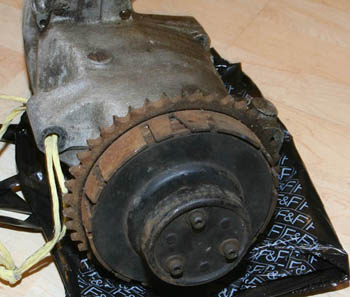
And on the other end - six spring Albion clutch (there was also a 3 spring version, but the dimples on the cover indicate the more desirable 6 spring version. Note lightening slots - as often done on racing clutch's!
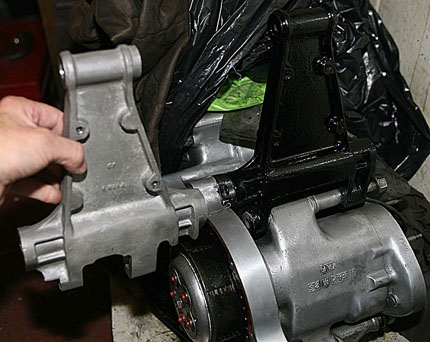
Probably one of the most difficult Grey Flash items to find - the rear gearbox/frame cast upright F106/1 - here shown side by side with the standard Comet item on the right. Note gearbox mountings in different places
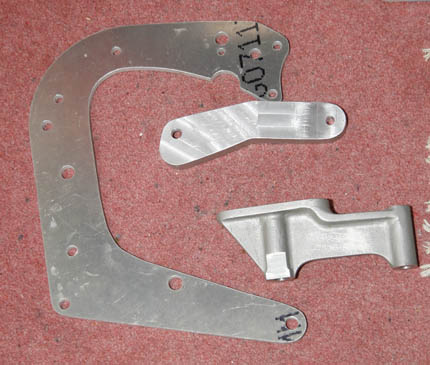
To go with the Albion Gearbox fitted to the original Grey Flash model . . . .The timing side outrigger plate for a Grey Flash, as well as the lower gearbox frame/gearbox mounts. As you can see, these are not from an original Grey Flash (there were only a handful made dont forget!), but have been copied from original items. It is these items as well as the correct Albion gearbox that make the major differences of a Grey Flash from a Comet
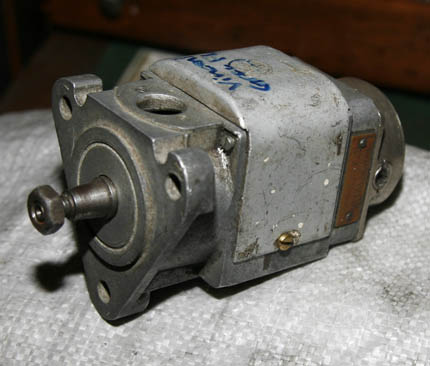
Vincent Comet models were fitted with a Lucas magneto with auto/advance mechanism (I have a couple of these spare for my own Comet). However, for the Grey Flash Vincent's fitted a flange fitting BTH TT magneto with manual advance/retard mechanism. I have this BTH flange fitting magneto earmarked for the Vincent. I will get it re-wound before use and probably fit Platinum points (the main differentiatior for competition BTH magneto's), which we can supply from our online RacingNorton catalog
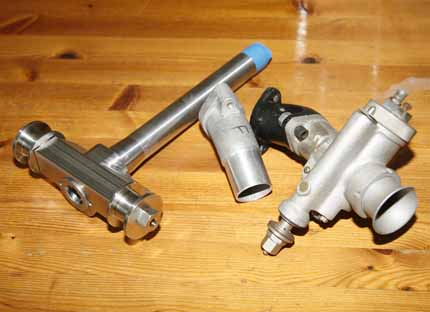
Some other items I have reserved for the Grey Flash Rep. on the left is possibly the most exotic - this is a special headstock
recently manufactured, which has different geometry from the standard Vincent Girdraulics. I am told it will transform the handling of a Vincent. I have a spare standard set of Girdraulics, which will have the alloy blades milled on the inside - as per original Grey Flash models, but will also fit this item.
On the right is a Grey Flash inlet manifold fitted to a long neck Amal RN carb, which is almost certainly the carb I will build onto the bike at the start. However, in the middle I also have a Grey Flash inlet manifold to fit the hard to find 32mm clip fitting RN/GP carbs . . . should one come my way!
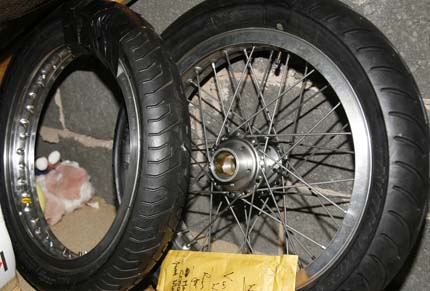
This picture goes under the heading of 'Recycling'. When I originally started building my Vincent Black Lightning Rep, I intended to race it in BHR meetings - therefore I originally built the wheels on 18" alloy rims using modern sticky race rubber. When later I realised I was more interested in originality, I took out the front hub and fitted it to a 21" rim, but had a second rear hub, so built that on an original 20" alloy rim and swapped over the remaining brake parts. Therefore, I still have a rear Vincent hub laced to old - but sticky 18" race tyres and an 18" front rim and spokes ready to be laced to a Vincent front hub, which I think I also have now. Things may change again, but as I write this, I still intend to use the Vincent GF in anger at twisty sprints at some point in the future, so these are the favoured choice at the moment
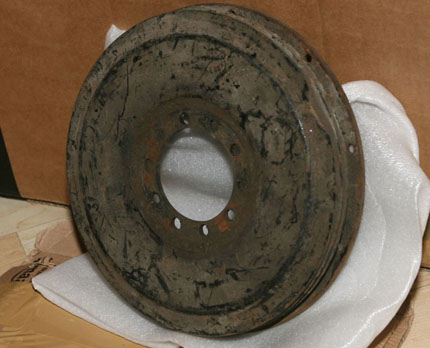
In my stash of parts for the Grey Flash rep is this racing rear brake drum, identifiable by the 10 holes for mounting to the hub (as fitted to the Shadow, Black lightning and Grey Flash) and fins. As per my Lightning - I am not sure at this stage if worth fitting two rear brakes - or just a sprocket carrier on one side
For the front wheels I have these original magnesium brake plates - still in black paint - so maybe fitted to a Black Lightning rep or similar twin, although just a small chance they could be original Grey Flash!
Interestingly, the original factory photographs showed the Grey Flash fitted with brake plates painted black, but I have seen genuine bikes with the brakes painted both grey and black. Not sure which to do mine yet . .. but I do need to buy finned brake drums, as these are items still missing from my build - although I have most other brake parts
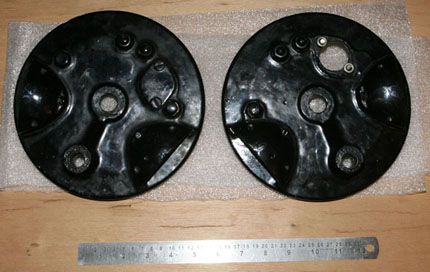
And finally . .. rear brake plates: Although I have one rear racing style brake drum, I dont have any of the Grey Flash/Lightning post war style brake plates. However, a few years ago I was lent the pattern for casting the pre-war style racing brake plate - which is identifiable from the Post-war type by having a circumferncial 'ring' cast into it - as can be seen here. I have these and a number of other unmachined plates. I need to get them machined up at some point, but painted black or grey - only the purist would spot the difference!
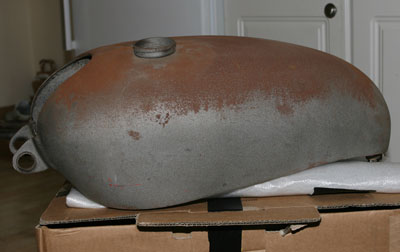
Petrol tank is a very standard and straight Vincent tank - which had been blasted by a previous owner, but left unpainted, so surface paint on top. I have sprayed in Duck Oil - but no point painting until I have engine built and big carb fitted and know that the tank cutaway underneath is suitable
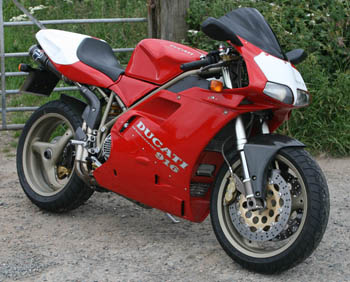
I have owned the 916 for almost 10 years now and still love its looks as well as its very fast handling married to a big loping Italian Vee-Twin engine
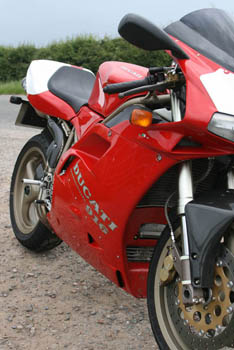
Beautiful classic lines of Ducati 916 made it as style icon when it first came out. It still looks good even now
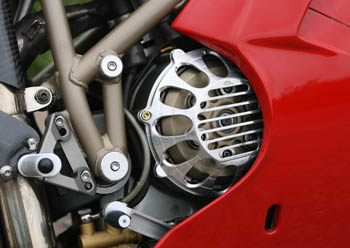
In the first couple of years of ownership I fitted or made lots of trick bits - like the Ducati Corse slipper clutch, billet footrests and lots of alloy and titanium fittings - there is a huge cottage industry for Ducati trick bits!
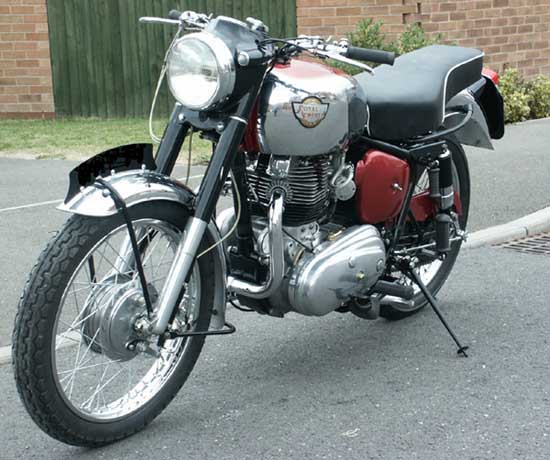
1959 Royal Enfield Constellation has been in my family since about 1973. I have owned it since 1983, but I restored it back to original in about 2004 (see Articles homepage)
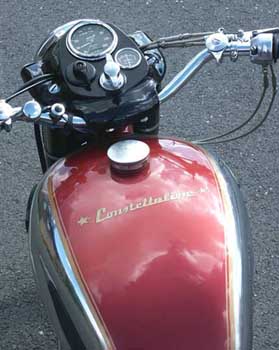
Cockpit view. 'Constellation' transfer adds to late '50's-early '60's style. Headlight binnacle houses a 150mph speedo
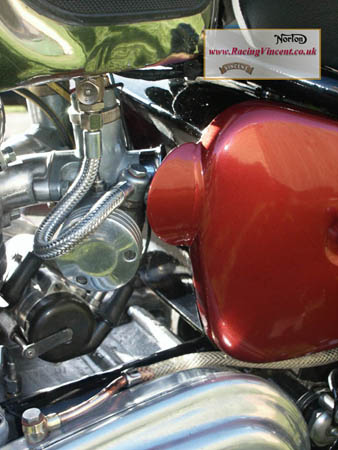
For many years before I restored the bike, it had black side panels and tank panel, but I always wanted to repaint in the metallic red - I was really pleased to find on stripping the side panels of original metallic red on the inside of the toolbox - which I was able to get matched, the colour shown here
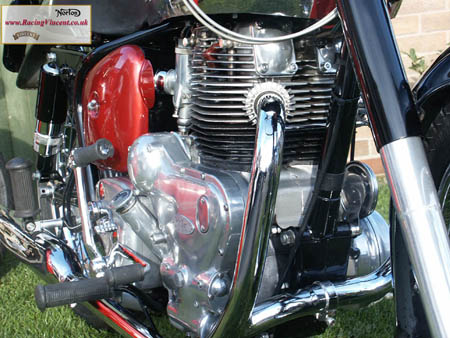
As restored, the bike looked very pretty and was to almost 100% original specification, including original mudguards re-chromed and even the 'Spike' sidestand, given to me 20 years ago by my old (late) friend Bob Pike, who had it left over from when he was a dealer in the 1950's
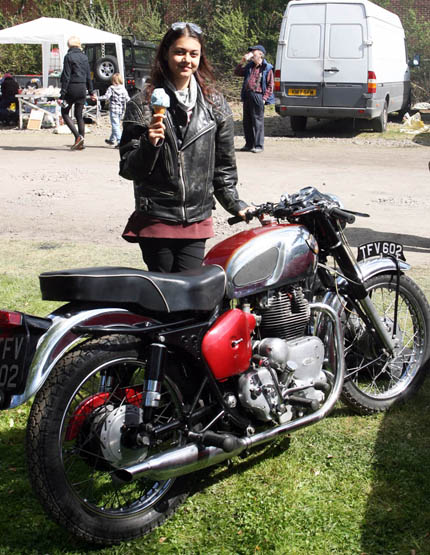
This photo was taken in about 2015 at a model traction engine exhibition at Market Bosworth - and this is my youngest daughter - Steph, playing biker chick . . . although I had to buy her an ice cream! Steph now runs the RacingNorton sales office and does our mail order side
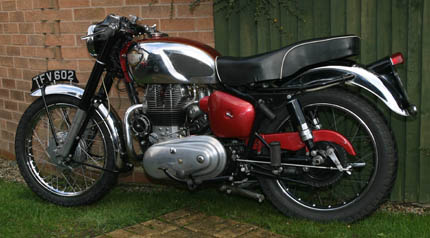
A few years on from the restoration I gave it, the Royal Enfield now has a less polished look, but still looks purposeful and is nice to ride - even if it does still leak its guts out around Leicestershire!
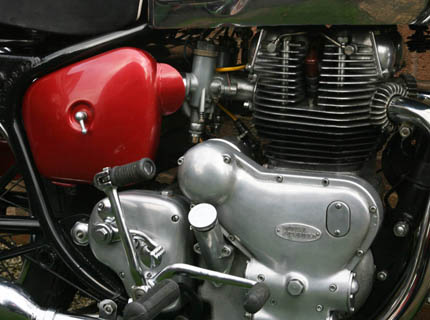
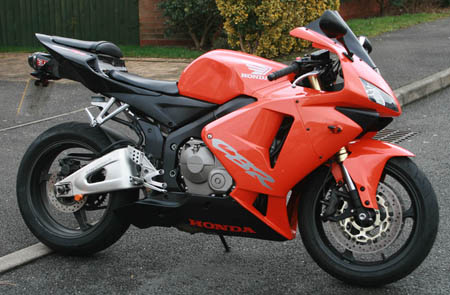
Most recent addition to the stable (i.e - my retirement home for old nags), is this Honda CBR600RR, bought in Dec 2013 as my new 'commuter' bike, to replace the KTM 660SMC, which some lowlife arsehole decided to nick from my works car park back in October '13
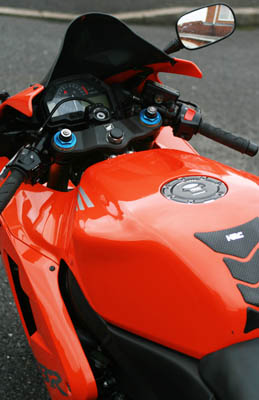
Hi-Tech cockpit (at least, it is for me!), has digital speedo and a rev clock that redlines at a staggering 15,000 revs, at which point this little 600 is doing just under 170mph!!
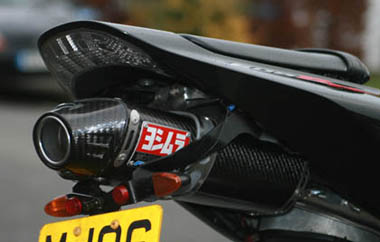
Absolute essential for any race replica that I get hold of, is to fit a louder pipe - as I like to hear the bike, and also be heard coming by other drivers! In this case, weapon of choice is a beautifully made Yoshimura RS-5 Carbon end can and stainless header which came from the US. As well as looking the dog's doohdah's - it gives the Honda the sound of a screaming Banshee!
Sorry if you are a member of the Noise Abatement society, but I was never very politically correct!
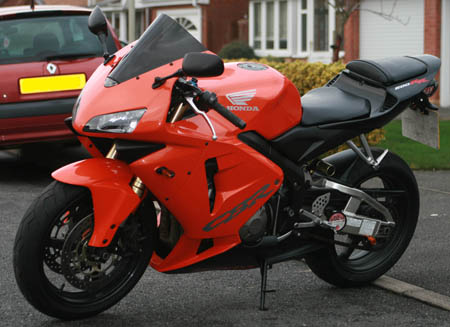
Honda has fantastic build quality and great looks, paint job is a very fetching shade of Orange. Although a 'Race Rep', I have found this to be a great bike for local commuting. Handling is super quick and on empty roads can be taken to silly angles, even by geriatrics like me
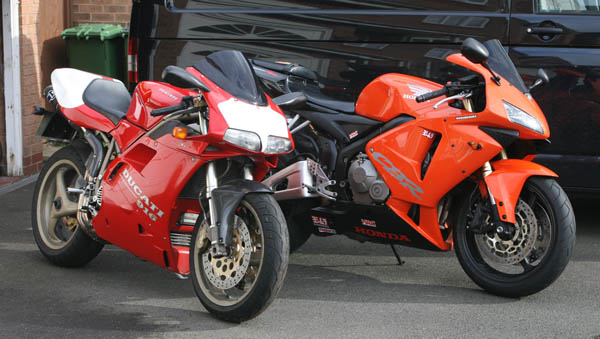
1997 Ducati 916 (in SPS trim) and 2006 Honda CBR 600RR. Both state of the art 'Race Replica's' when they were new and both still beautiful in their own right. What amazes me is just how similar they look in design and hard to believe the Ducati is 9 news older than the Honda. Both are fantastic to ride - and both have super quick handling, although the Ducati has big loping Vee-twin engine, while the Honda has a screaming 600 4 cylinder jewel of an engine - reminiscent of what a 1960's grand prix Honda engine must have sounded like
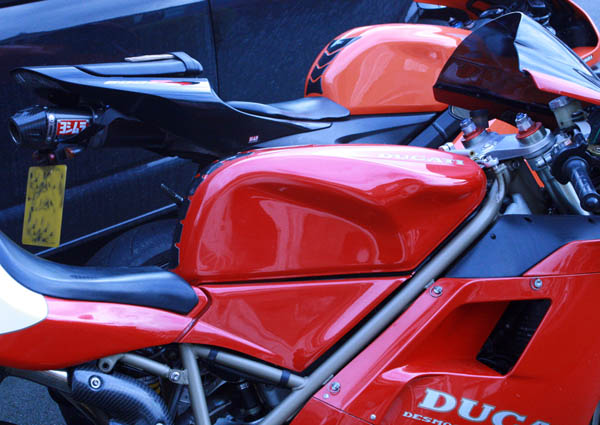

Douglas 2 3/4 hp loosely assembled after a 4 month flurry of early restoration tasks, so I could overall fit before stripdown. Not long after this photo was taken the bike was stripped down to do many of the more time consuming restoration tasks. Now in early 2019 the reassembly from the chassis up has recommenced. Below is hte project bike as purchased from Bonhams Stafford Sale in April 2016
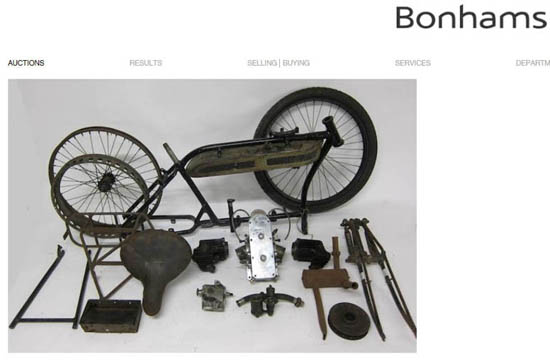
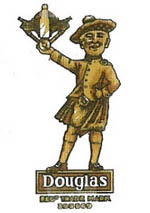
Back in 2016, on a visit to Bonhams Stafford Auction to buy some Vincent parts for my Vincent Grey Flash build - instead I ended up coming away with a Douglas Flat Tanker project - as I have secretely held a desire to own a flat tanker from this marque, ever since I competing against them in Sprint's in the early 1980's.
Since then, as well as being well progressed in the build of the 1920 Douglas - as a TT Rep (loosely based on the racing Douglas 2 3/4hp models - I am also well progressed in the collectioin of parts to build a second bike - I would like to one day consider building a replica of the first 1914 OHC racing bike - which used crankcases and bottom half from teh SV 2 3/4 hp model. As I write this update in March 2019, the build of the first is now progressing well, wiht chassis stripped, painte and now being built back up, engine rebuilt, and wheels also completed - themselves quite a big job on a Belt drive motorcycle. A cojuple of articles on the Douglas are included below

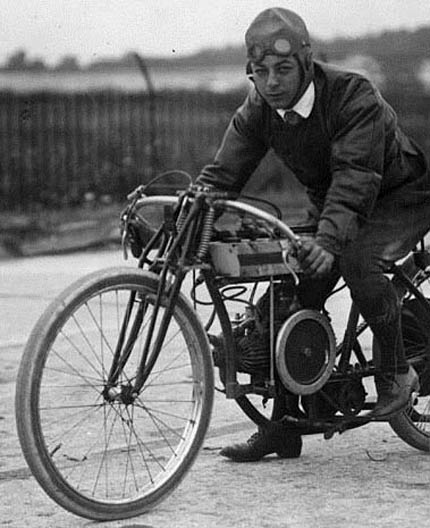
Period shot of Les Bailey at Brooklands in 1913 on similar Douglas 2 3/4 hp Works racing bike. I would like to build my Douglas to similar TT Rep spec. Not really sure if there was an official TT Replica model - but there was definitely TT style handlebars offered on roadgoing bikes

Ready for taking to Brooklands 2016 - although only loosely assembled, it was great to show this bike off, and with the 'Works' type handlebars fitted (only the Douglas Works bikes seem to have had handlebars mounted below the top links) it certainly looked the part and got plenty of positive attention!
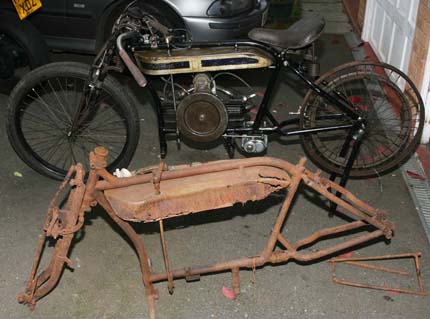
As so often happens when I get the 'new restoration' urge - within 6 months of buying the first project . . . I was already starting to accumulate parts for the next one! In this case, alongside the 1919-1920 project bike, I then purchased an extremely rough 1917 Douglas 2 3/4hp frame, to go with the second engine I already had - a possible donor for a 1914 OHV TT rep!
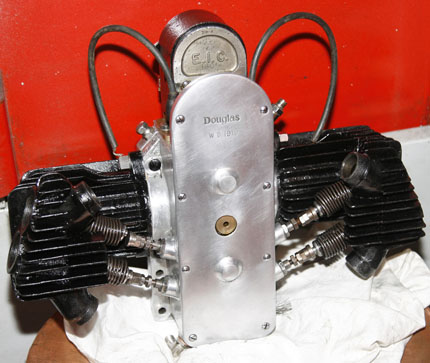
This photo taken in early 2019 - it shows the original project engine now put back together and ready to go back into the bike. I wanted to say 'rebuilt' but that would make me out to be a bit fake - the crank already felt good . . . and what looked remarkably like the original main bearings still looked good as well. The previous owner had already semi-restored the crankcases and gears - I just stripped and cleaned everything carefully - then worked on barrel, pistons and valve gear - I will cover this in a future article
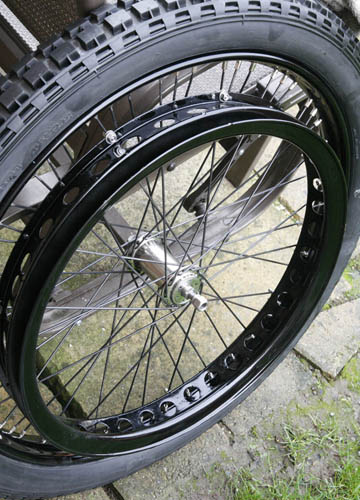
Beaded Edge wheels were rebuilt in second half of 2018. Rims were too far gone to be safely reused, but hubs were - as was the original Douglas beltrim. This is a picture of the rear wheel after rebuilding. I had to say, I was quite proud of the final finish - original Douglas hub, belt rim with new beaded edge rim, 26 x 2.5" rim, my own belt rim securing clamps (see our new 'Douglas Parts' section of the RacingNorton online catalog to buy similar) - and respoked myself . . . took far too long to do, but very satisfying now I have done it! Front wheel is similar, but 26 x 2" as that goes into earlier pre-1918 forks
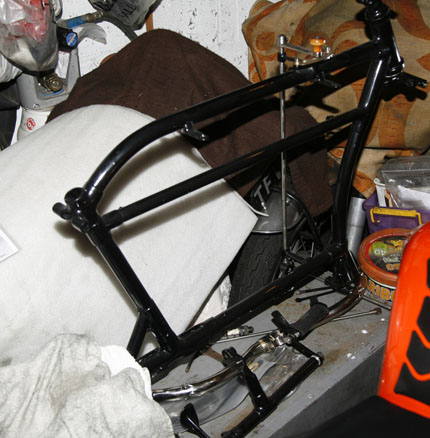
. . .Not a very exciting photo I grant you - but this shows you what the project build looks like in April 2019 - frame and subframe parts have all been rubbed down, cleaned up and 2-pack black resprayed. Engine rebuilt and ready to go in. Forks are hanging up next to frame out of shot -but are just awaiting new fork spindles to be made, before i start putting everything together. Although not immediately obvious, on the build bench are the Douglas footrest assembly amongst other finished and nickelled parts
to cover the Douglas builds :


